#ATP Challenger
Explore tagged Tumblr posts
Text
Know Your Talents: 2024 ATP NextGen Finals Introductory Post

The 2024 ATP NextGen Finals Class of 2024 (📸 NextGen Finals' official Twitter)
It is that time of the year again when the 8 best under-20 players of the 2024 season battle it out at the 2024 NextGen Finals, which will be held in Jeddah starting today (December 18). However, in contrast to being the season-ending campaign for them, it could be treated as one of their preparations to start the next season, as it is organized in transition between the end of the 2024 season and the beginning of the 2025 season (December 18-22, 2024), the timing when other exhibition tournaments take place.
Interestingly, the qualification window for this year's NextGen Finals ended at the end of the 2024 ATP Challenger Tour season (December 1) according to the rulebook, allowing the lower end of the Race to slightly heighten up, while no wild card is awarded due to no U-20 player standing out from the region, which meant all 8 players qualified through the Race. As a result, the last few names were attained at the end of November after several other names nearby got eliminated early in their pursuit to qualify for this event. As a reminder, they will play in best-of-five mini-sets (first to 4 games), with a tie-break to be played at 3-3, deciding points (servers' choice) every deuce without let on serve.
Featuring 4 players in the Top 50 for the first time since 2018 despite being U-20 only, hereby introducing this year's NextGen Finalists and their #JourneytoJeddah according to their seedings and respective groups:
Blue Group
1. Arthur Fils

Arthur Fils with his Hamburg 500 title (📸 Univers Tennis)



Arthur Fils' points to 6-5* 40-ad (latest set point) in Estoril (250) R1 (top left), to save a match point to 6-6(6-6), 2nd set in Tokyo (500) finals (top right), and his breakthrough highlights of 2024 (bottom) (📸📝BeIN Sports ID, ATP official website, and Tennis TV via Tennis Channel)
One of the front-runners of this year’s NextGen Finals, A. Fils enjoyed his further breakthrough after becoming the runner-up to Hamad Medjedovic in last year’s iteration 1-4, 2-4, 4-3(9), 1-4. Despite the slow start to the season, especially as he tried his hands in the Golden Swing (including a straight-set loss to Joao Fonseca in the first-round match of the Rio de Janeiro (500)) instead of his favorite European indoor-Middle Eastern swing, it steadily paid off as he won the Bordeaux (175) title rather than defending his Lyon (250) title, defeating Pedro Martinez 6-2, 6-3 thanks to a dominant play. Before that, he retired Joao Sousa 7-5, 6-4 in the Estoril (250) first round before bowing out to Cristian Garin 6-2, 4-6, 4-6 in the second round.
Performing even better in the second half of the season, A. Fils defeated Dominic Stricker, Hubert Hurkacz, and Roman Safiullin in the first three rounds of the Wimbledon Championships before being defeated by Alex de Minaur 2-6, 4-6, 6-4, 3-6 in the fourth round. He went on to reach his maiden 500-level final in Hamburg (500), defeating Alexander Zverev 6-3, 3-6, 7-6(1) for his first 500-level title. Not long after, he won his second 500-level title in Tokyo (500), snapping Ugo Humbert's perfect finals record after saving a match point, turning the match around with a final scoreline of 5-7, 7-6(3), 6-3 in 3 hours and 4 minutes. Followed by a semifinal appearance in Vienna (500) (l. Ben Shelton 3-6, 6-7(9)) and being eliminated in the third round of Paris M1000 (l. A. Zverev 4-6, 6-3, 3-6), A. Fils enjoyed a career-high ranking of 20 to close his stellar 2024 season, qualifying him for this tournament right away.
4. Jakub Mensik

Jakub Mensik (right) as the Doha (250) runner-up to Karen Khachanov (left) (📸 El Mundo Deportivo via EFE)



Jakub Mensik's points to hold 3-3 in the 1st set of his Doha (250) final (top left), to 2-1* 15-15 in the 2nd set of his Rome M1000 1st round match (top right), and to break 3-0 in the 2nd set of his Vienna (500) second round match (bottom) (📸 ATP Tour's official Twitter via TennisTV)
After notably ending his season with his maiden Challenger-level quarterfinal appearance in Danderyd (d. Hamad Medjedovic 4-6, 7-6(2), 7-6(8) in the second round only to be defeated by his fellow #NextGenATP Alexander Blockx 0-6, 3-6 in the quarterfinals), J. Mensik began his season by becoming the runner-up of the Canberra Challenger (l. Dominik Koepfer 3-6, 2-6) before advancing to the second round of the Australian Open as a qualifier (l. Hubert Hurkacz 7-6(9), 1-6, 7-5, 1-6, 3-6). He then continued by reaching the semifinals of the Manama Challenger (l. Mikhail Kukushkin 3-6, 2-6), boldening his breakthrough by becoming the runner-up of Doha (250) the week after to Karen Khachanov 6-7(12), 4-6. However, he was sidelined due to an elbow injury, trying to come back in Madrid Masters 1000 only to retire at the start of the second set against Felix Auger-Aliassime 1-6, 0-1, forcing him to be sidelined for the rest of the clay season. He cited that the biomechanics of his serve caused the injury, making necessary adjustments for the rest of the season (apart from taking his final exams at school, where he got 4 As).
The Czech youngster then came back stronger during the grass season, reaching the quarterfinals of Mallorca (250) (l. Alejandro Tabilo 4-6, 4-6) before exiting early in the first round of Wimbledon to Alexander Bublik 6-4, 7-6(3), 4-6, 4-6, 2-6. Adding to his breakthrough year, he became the semifinalist of Umag (250) (l. Lorenzo Musetti 4-6, 1-6), partaking in his first Summer Olympics as he got eliminated against Tommy Paul 3-6, 1-6 in the second round. His progress became more evident in the other hard-court season, where he reached the third round of the US Open (l. Nuno Borges 7-6(3), 1-6, 6-3, 6-7(6), 0-6), as well as reaching the quarterfinals of the Shanghai M1000 (l. Novak Djokovic 7-6(4), 1-6, 4-6). He then concluded his season with a stellar showing in Vienna (500), being a quarterfinalist to Alex de Minaur 7-6(2), 3-6, 4-6 before retiring against Corentin Moutet upon the conclusion of the first set in the second qualifying round of Paris M1000 (6-7(3), ret.) due to fatigue, considering his Vienna run. He ended his season with a career-high ranking of 48, actually setting his goal to “stay injury-free,” considering the physical issues that often appeared from some thrilling matches. To top it off, he is deservingly being voted by his fellow players as the "Newcomer of the Year," announced right before the NextGen Finals.
6. Joao Fonseca

Joao Fonseca celebrating his victory in the Rio de Janeiro (500), where he reached his maiden ATP-level quarterfinals (📸 Tennis.com)



Joao Fonseca's points to 4-2, 2nd set, in his Asuncion Challenger final match (top left), to break back 5-5 in the 2nd set in his Lexington Challenger second-round match (top right), and setting up his latest set point before taking the 2nd set 7-6(8) in his Brest Challenger quarterfinal match (bottom) (📸 ATP official website, BeIN Sports ID)
J. Fonseca’s big raw potential was spotted in the South American Challenger circuit as early as 2022, reaching his first Challenger-level quarterfinal in Sao Leopoldo at that time after stunning Mariano Navone 3-6, 6-1, 7-6(9) in the second round, bowing out to Facundo Bagnis 3-6, 4-6 in the quarterfinals. Since then, he has taken the world by storm, peaking through winning the 2023 US Open Junior Boys' Singles by defeating his fellow #NextGenATP Learner Tien 4-6, 6-4, 6-3 after a rain delay interrupted the match. The Brazilian then started the year by winning the Buenos Aires 2 (Argentino) Challenger title with Pedro Sakamoto (d. Jakob Schnaitter/Mark Wallner 6-2, 6-2 as alternates), preceding his bigger breakthrough in Rio de Janeiro (500) as a wild card as he knocked out Arthur Fils in straight sets in a talent-off and Cristian Garin in the round after, setting up a rematch of his second-round Sao Leopoldo Challenger from 2 years ago despite the loss against Mariano Navone 6-2, 3-6, 3-6 in his maiden ATP-level quarterfinals.
Afterward, J. Fonseca, who already enrolled at the University of Virginia at the end of 2023, forewent his eligibility and turned pro, enjoying notable milestones along the way despite the rollercoasters. He went on to reach his maiden Challenger-level final in Asuncion after saving 2 match points in the quarterfinals against Orlando Luz 3-6, 7-6(4), 6-2 before Gustavo Heide got the best out of him in the finals 5-7, 7-6(6), 1-6 in a battle for their maiden Challenger title. He reaped his rewards when he received wild cards to Estoril (250), Bucharest (250), and Madrid M1000, racking up experience despite the early exits. His moment then finally came as he won the Lexington Challenger, defeating Li Tu 6-1, 6-4 in the finals, followed by advancing to the US Open third qualifying round as he lost the tight match against University of Texas alumnus Eliot Spizzirri 6-7(8), 7-6(5), 4-6. Continuing his season indoors, he notably saved 10 match points across the second and the third sets before being defeated by eventual runner-up Benjamin Bonzi 4-6, 7-6(8), 4-6 in the Brest Challenger quarterfinals, surviving a talent-off by defeating Martin Landaluce 6-2, 3-6, 7-6(9) in the Lyon (Décines-Charpieu) Challenger quarterfinals before bowing out to one of the indoor goats Calvin Hemery 6-7(5), 4-6 in the semifinals. From here alone, he attained his career-high ranking of 145 by November 18, 2024, securing his qualification to the NextGen Finals thanks to his powerful play, crediting the Challenger Tour for his development.
7. Learner Tien

Learner Tien won his maiden Challenger-level title in the Bloomfield Hills Challenger (📸 Shankar Iyer/Cranbrook Tennis Classic via Tennis TourTalk)



Learner Tien's points to *2-2 15-15 in the 1st set of his Bloomfield Hills Challenger second-round match (top left), to break 5-3 in the second set of his Tiburon Challenger second-round match (top right), and to start the second game of the first set of his famous Fairfield Challenger final match (bottom) (📸 ATP official website)
Former junior World No. 4 (attained in 2023) Learner Tien, who is named after his mother's profession as a teacher, took the world by storm starting his runner-up to Alexander Blockx in the 2023 Australian Open Junior Boys' Singles, winning the U-18 National Championships in the United States two consecutive times (2022-23), which qualified him for the US Open Main Draw wild card. To add, he became the runner-up to Joao Fonseca in the 2023 US Open Junior Boys' Singles (with the final scoreline of 4-6, 6-3, 3-6), whom he will face in this group as well. He attended the University of Southern California in 2022/23, where he earned the All-Pac-12 honorable mention in a shortened season, going 3-0 in singles at the No. 2 position, and 6-3 in doubles at the No. 1 spot.
While his professional journey has had its ups and downs, Learner started to gain more attention in the middle of 2024, kickstarting what would be his 28-match winning streak by winning titles in ITF M15 San Diego (May 27 and Jun 3) before continuing with another title in ITF M15 Rancho Santa Fe (Jun 17). The streak did not stop as he won his maiden Challenger title in the Bloomfield Hills Challenger, defeating Nishesh Basavareddy 4-6, 6-3, 6-4 in an extremely dynamic affair, surviving all his previous rounds in 3 sets. It did not end from here as he went on to win the ITF M15 Lakewood (Jul 8) by defeating Govind Nanda 6-3, 6-3, but his winning streak was snapped by Yunchaokete Bu 4-6, 5-7 in the semifinals of the Chicago Challenger before reaching his maiden ATP-level quarterfinal as a qualifier in Winston-Salem (250) (l. Pablo Carreno Busta 4-6, 2-6). Learner then won the Las Vegas Challenger by defeating Tristan Boyer 7-5, 1-6, 6-3 before crushing Bernard Tomic 6-0, 6-1 to win the Fairfield Challenger title in 39 minutes, setting the record for the all-time fastest Challenger final both in game (13 games) and duration (39 minutes), as well as becoming the fourth American to win 3 Challenger titles before turning 19 right behind Taylor Fritz, Andy Roddick, and Sam Querrey. Learner then closed the season with a runner-up in the Knoxville Challenger to Christopher Eubanks 5-7, 6-7(9), reaching a career-high ranking of 114 to open up a possibility for a Top 100 ascension apart from qualifying for the NextGen Finals, inducting himself to the ITF Class of 2024 thanks to his rapid rise.
Red Group
2. Alex Michelsen

Alex Michelsen (right) before contesting his 2024 Newport (250) final against Marcos Giron (left) (📸 Tennis TV)


Alex Michelsen's point to 1-0* 0-15 (2nd set) in his Newport (250) semifinal match (left) and to 6-6(3-0) (1st set tie-break) at his Winston-Salem (250) first-round match (right) (📸 Tennis Channel and Tennis TV)
Also a repeater from the 2023 NextGen Finals (eliminated in the group stage) thanks to his rise that peaked with the Knoxville Challenger title last year, A. Michelsen became a direct entrant to the 2024 Australian Open, qualified for the third round before being eliminated to Alexander Zverev 2-6, 6-7(4), 2-6. He also notably forced the issue when he saved 3 match points before being defeated by Jordan Thompson 6-0, 6-7(1), 5-7 in the quarterfinals after recording one of his biggest victories by knocking out Alex de Minaur 6-4, 6-1 the round before in Los Cabos (250). After a decent start to the hard-court season, the American accustomed himself to the red-clay season by partaking in the Oeiras 3 Challenger, defeating home favorite Henrique Rocha 4-6, 6-3, 6-4 in the first round before Dennis Novak knocked him out 6-7(3), 4-6 in the second round, but he ended his subpar clay season with an early exit to Alex de Minaur 1-6, 0-6, 2-6 in the first round of Roland Garros.
A. Michelsen then bounced back in the grass and hard-court seasons. Despite kicking off his grass season with a straight-set loss to a resurgent Paul Jubb, he continued by reaching another quarterfinal in Mallorca (250), where Alejandro Tabilo won 6-4, 6-4, but exited early in a 5-set first-round Wimbledon match against Lloyd Harris. The American then closed the grass season by retaining his runner-up position in Newport (250), where Marcos Giron got the best out of him 6-7(4), 6-3, 7-5 in the finals. He then became the runner-up of Winston-Salem (250) to Lorenzo Sonego 0-6, 3-6, but notably defeated Stefanos Tsitsipas 4-6, 6-1, 6-2 in the first round of Tokyo (500) before losing to Tomas Machac 6-7(2), 3-6 in the second round. Indoors, he confidently knocked out Hubert Hurkacz 6-3, 6-1 in the first round of Paris M1000 before being eliminated in the round after, becoming the Metz (250) semifinalist by knocking out the likes of Richard Gasquet and Harold Mayot before a comeback Benjamin Bonzi bettered him with the final scoreline of 6-4, 0-6, 5-7. By November 11, 2024, he reached his career-high ranking of 48, qualifying himself for the NextGen Finals alongside his junior buddies (in his batch) Learner Tien and Nishesh Basavareddy.
3. Juncheng Shang

Juncheng Shang with his maiden ATP title in Chengdu (250) (📸 CFP via CGTN)


Juncheng Shang's point to save the second match point to 6-6(8-8) in his Hong Kong (250) first-round match (left) and to break 6-5 (1st set) in his Chengdu (250) final match (right) (📸 Tennis TV, ATP official website)
Also having immense potential to his name, Jerry became the first Chinese man to win the Australian Open main draw match in 2023 by defeating Oscar Otte 6-2, 6-4, 6-7(2), 7-5 in the first round. Since then, despite some fitness-questioning moments, Jerry continued to make his mark, which was just the beginning of what could be a career. Fast-forward to the start of the 2024 season, Jerry qualified for the Hong Kong (250) semifinal as a wild card before bowing out to Andrey Rublev 6-4, 2-6, 3-6, also receiving a wild card to the Australian Open, where he knocked out Mackenzie McDonald and Sumit Nagal before retiring against Carlos Alcaraz 1-6, 1-6, 0-1 in the third round. He continued his strides in the Sunshine Double, where he notably reached the second round of the Indian Wells M1000 as a qualifier (d. Jordan Thompson 6-2, 6-3 in the first round before being eliminated to Alexander Bublik 4-6, 1-6). On the clay-court season, he notably partook in the Madrid Challenger, defeating Alejandro Moro Canas 7-5, 6-2 in a tight match before being eliminated in the next round against Marc-Andrea Huesler 4-6, 6-3, 5-7 in a classic encounter. Right after, he reached the second round of Barcelona (500) and Madrid M1000 (l. Alejandro Davidovich Fokina 5-7, 3-6 in a match famous for its double-bounce incident midway), ending his clay season with a semifinal appearance in Bordeaux Challenger (l. Pedro Martinez 5-7, 2-6) before suffering an early exit in the first qualifying round of the Roland Garros to Roman Andres Burruchaga 4-6, 6-7(5).
Furthermore, Jerry also shone during the grass season, having a competitive showing despite the loss against a rising Jacob Fearnley 5-7, 5-7 at the Nottingham (grass) Challenger quarterfinals, reaching the Eastbourne (250) quarterfinals as well, being eliminated to Taylor Fritz 6-7(5), 6-7(5) as it came down to some crucial points. He ended the grass season by going out of the Wimbledon Championships’ second round against Grigor Dimitrov 7-5, 7-6(4), 4-6, 2-6, 4-6, peaking during the other hard-court swing by reaching the semifinals of Atlanta (250) as a qualifier (l. Jordan Thompson 6-3, 4-6, 3-6) despite the two walk-overs that occurred back in Washington (500) (retiring 2-3 down in the first set to Arthur Rinderknech in the second round due to his lower back injury) and Winston-Salem (250) (withdrew from his third-round match) and the first-round loss to Casper Ruud in another 5-set chaos (final scoreline: 7-6(1), 6-3, 0-6, 3-6, 1-6), before winning his maiden ATP-level title in Chengdu (250) (d. Lorenzo Musetti 7-6(4), 6-1, notably defeating Kei Nishikori (R1), Roman Safiullin (R2), and Alexander Bublik (QF) midway). Jerry ended his season Indoors by qualifying for the Paris M1000, bowing out to Marcos Giron 6-7(6), 6-7(6) in another competitive showing. Reaching his career-high ranking of 47 back on October 21, 2024, Jerry is looking forward to competing in the NextGen Finals, trying to stay happy on the court while maintaining his continuous learning spirit.
5. Luca van Assche

Luca van Assche after winning against Cameron Norrie in his Roanne Challenger quarterfinal match (📸 TennisActu via Roanne Challenger's official Instagram)


Luca van Assche's point to 5-2* 30-30 (2nd set) in his second-round Heilbronn Challenger match (left) and to *1-2 0-15 in his Roanne Challenger quarterfinal match (right) (📸 ATP official website)
Compared to his steady rise that qualified him for the 2023 NextGen Finals, Luca van Assche struggled to maintain his form, trying to balance his tennis journey with his undergraduate studies, currently majoring in Mathematics at Paris-Dauphine University. He kicked off this season with a second-round exit to Cameron Norrie 3-6, 7-6(5), 1-6 before notably recording back-to-back 5-set wins in his first two rounds of the Australian Open, bowing out to Stefanos Tsitsipas 3-6, 0-6, 4-6 in the third round. Trying to find his form upon appointing Vicenzo Santopadre (Matteo Berrettini’s coach for 13 years), it was a rocky road for him for some parts of the year: suffering quit exits from the first rounds of Marseille (250) and Rotterdam (250), as well as the first qualifying round of Doha (250) before qualifying for Dubai (500), where Karen Khachanov got the best out of him 2-6, 3-6 in the first round. To continue, he reached the semifinal of the Phoenix Challenger (l. Nuno Borges 4-6, 6-4, 2-6), but another set of early exits occurred, reaching the second round at best in Miami M1000 (l. Casper Ruud 6-7(5), 6-1, 1-6), Barcelona (500) (retiring against Fabian Marozsan 0-6, 2-3), and Madrid M1000 (l. Sebastian Baez 4-6, 7-6(2), 3-6), topping it off with a loss to a comeback Denis Shapovalov 3-6, 4-6, 4-6 in Roland Garros, continuing with 3 consecutive three-set victories in the Heilbronn Challenger the week after before bowing out to eventual champion Sumit Nagal 2-6, 6-7(5) in the semifinals, continuing with a quarterfinal showing in Lyon (clay) Challenger (l. Raphael Collignon 5-7, 3-6) and second-round loss to Tristan Boyer (2-6, 5-7) in the Sassuolo Challenger.
L. van Assche was one of the Wimbledon lucky losers, after being eliminated in the third qualifying round against Lucas Pouille 6-7(4), 5-7, 2-6 in a French generational affair, but he was defeated by Fabio Fognini 1-6, 3-6, 5-7 in the first round despite stepping up late in the third set. Among the other quick eliminations occurring during the other hard-court season, he went out to Paul Jubb 3-6, 1-6 in the second round of the Lincoln Challenger, Gabriel Diallo 4-6, 3-6 in the Cary Challenger second round, Radu Albot 2-6, 6-0, 4-6 in the second qualifying round of the US Open, as well as to the eventual champion Gijs Brouwer 3-6, 2-6 in the first round of the Saint-Tropez Challenger. Seeing his Top 100 ranking is on the line, L. van Assche survived the season thanks to some tumultuous runs, starting from a second-round loss in Villena Challenger to another #NextGenATP in Justin Engel 6-3, 4-6, 0-6, followed by a semifinal showing in the Roanne Challenger (l. Benjamin Bonzi 4-6, 1-6 despite coming back from a set and a break down in the quarterfinals against Cameron Norrie 1-6, 7-5, 6-3, being a quarterfinalist of the Brest Challenger (l. Otto Virtanen 6-7(1), 4-6), had an epic loss after Jozef Kovalik came back and forth from the brink in the first round of the Bratislava 2 Challenger 6-4, 6-7(5), 6-7(0), then becoming a lucky loser in Metz (250) despite his first-qualifying-round loss to Gregoire Barrere 3-6, 4-6 as Cameron Norrie asserted his revenge in the first round 3-6, 6-3, 1-6. This resulted in the Frenchman being ranked 128 at the end of the season, but he is looking to end 2024 with a bang with a run in the NextGen Finals, taking the court first today against Juncheng Shang to start his campaign in this tournament as he drew from his last year’s experience, where he lost in the semifinals against Arthur Fils.
8. Nishesh Basavareddy

Nishesh Basavareddy with his maiden Challenger-level title in Tiburon (📸 ATP official website via Natalie Kim Photography)



Nishesh Basavareddy's points to 5-1* 30-40 (1st set) in his Tiburon Challenger final match (top left), to 0-0* 40-ad (2nd set) to set up one of his break points in his second-round Knoxville Challenger match (top right), and to *3-3 30-15 (bottom) in an exciting sequence at his Puerto Vallarta Challenger final match (bottom) (📸 ATP official website)
Notably a former junior World No. 3 (attained on January 3, 2023), Nishesh Basavareddy attends Stanford University, majoring in Data Science, where he also was awarded ITA Scholar-Athlete twice for his outstanding academic achievement before foregoing his remaining eligibility thanks to a standout season. Back in college, he was a two-time All-American and the ITA Fall National Champion in 2022, leading the Stanford Cardinals to a Pac-12 Championship earlier in 2024, as well as being an All-Pac two-time honoree, having a 41-11 record in singles (14-1 at the top position) and 29-14 doubles record, reaching a career-high collegiate ranking of No. 6 in singles. In addition, while still actively playing in college, apart from attaining his first ATP points in 2022, he also won his first professional doubles title in ITF M15 Vero Beach (Apr 25) with Ricardo Rodriguez-Pace, defeating Liam Draxl/Millen Hurrion 6-4, 6-3 in the finals and becoming the singles runner-up of the 2023 Fairfield Challenger (l. Zachary Svajda 4-6, 1-6) at his maiden Challenger-level singles final.
However, the Carmel, Indiana native started another rise, beginning with his ITF M25 Calabasas (Mar 18) runner-up when Trevor Svajda got the best out of him 4-6, 1-6. Since then, he had a tear in the North American Challenger circuit in general, starting from becoming the runner-up to Learner Tien 6-4, 3-6, 4-6 in the Bloomfield Hills Challenger (in singles) and partnering Ozan Baris, in doubles (l. Ryan Seggerman/Patrick Trhac 6-4, 3-6, [6-10] in the finals). He then reached the semifinal of the Lincoln Challenger (l. Coleman Wong 7-6(5), 6-7(3), 0-6) before reaching the third qualifying round of the US Open, where Hamad Medjedovic won 6-4, 6-7(5), 6-1, with fitness being the main question of this stretch, including in his Columbus Challenger loss to James Kent Trotter 7-6(4), 1-6, 0-6 in the semifinals. However, Nishesh came back stronger with other final stretches, starting with a runner-up to Edas Butvilas 4-6, 3-6 in the Charleston Challenger in a battle for their maiden Challenger title, finally winning his maiden Challenger title in Tiburon as he double-breadsticked (6-1, 6-1) University of Texas alumnus Eliot Spizzirri as they contested for their maiden Challenger title as well. Somehow, within 2 months, Nishesh became a runner-up in 2 different Challenger-level tournaments, starting the Charlottesville Challenger (l. James Kent Trotter 3-6, 4-6), followed by the Champaign Challenger a fortnight later (l. Ethan Quinn 3-6, 1-6) while surviving various classics along the way, including the quarterfinal match against University of Virginia alumnus Chris Rodesch 6-4, 6-7(6), 7-6(5) in the quarterfinals back in Charlottesville. Despite the injury scare to end the season, Nishesh closed the season in the Puerto Vallarta Challenger with a title, defeating Liam Draxl 6-3, 7-6(4) after not being able to serve it out in the second set, thus achieving a career-high ranking of 138 on December 2, 2024, securing the last spot to the NextGen Finals, as well as becoming the basis of him turning professional by the end of this year thanks to the immense development in his point construction as reflected in some above samples.
#atp tour#atp world tour#atp challenger#atp challenger tour#tennis news#tennis updates#nextgen finals#nextgen finals 2024#introductory post#arthur fils#alex michelsen#juncheng shang#jakub mensik#luca van assche#joao fonseca#learner tien#nishesh basavareddy#WatchChallengersFolks#ChallengerMatters#KnowYourTalents#JourneytoJeddah
12 notes
·
View notes
Text
Nagal Falls Short in Basel and Paris, Eyes Return to Form in Upcoming Events
Sumit Nagal’s search for an ATP main draw qualification continued as he failed to qualify in the ATP 500 Swiss Indoors and the ATP 1000 Paris Masters. He had last made the main draw of an ATP 500 or above event at Monte Carlo Masters in April this year where he made the second round after qualifying beating higher ranked opponents on his preferred Clay courts. Swiss Indoors In the Swiss Indoors…
0 notes
Text











📸 🎥 TC Int'l
The third set brought out the best of both players' games, but how they handled the pressing moments became the most crucial aspect toward the end of this match. V. Kopriva somehow won the first two points of this set thanks to a backhand winner after a swift return set things up, but L. Darderi went on to win the next few points and held to 1-0 to start the proceedings. He then tried to respond through a working drop-shot to start the next game, but V. Kopriva remained solid and held his serves to 1-1 despite the first seed's best chances. This was also the case in the next game, where a return ace from V. Kopriva's forehand side set up another 2-point lead, but the Italian first seed still held his serves to 2-1.
In the next two games, V. Kopriva's re-drop-shot in response to L. Darderi's preceding drop-shot set up his initial break point, but even though there was another chance made thanks to a cross-court backhand winner, the latter scored a gigantic hold to 3-2 to close the game. There was a fourth-shot forehand winner from V. Kopriva that opened the ninth game as he tried to assert some scoreboard pressures, but L. Darderi still held to 5-4 at the end of that game, and this continued with the latter's backhand error that set himself a point ahead right before a third-shot error for V. Kopriva's initial break points, but the home favorite still held his serves to 6-5.
L. Darderi then began the next game with a forehand winner as he tried to assert more scoreboard pressure, but the tie-breaker became inevitable as V. Kopriva held to 6-6. Setting up the early mini-break through a successful lob to 1-0, the Czech's double-fault only equalized the point to 1-1 before L. Darderi's forehand winner set up his mini-break to 2-1. The former's forehand return winner then got him back onboard to 2-2 before his anticipative response to L. Darderi's drop-shot ended in the first seed's error to mini-break 3-2. Even if V. Kopriva's unforced error briefly put L. Darderi back on serve, the latter's +1 forehand error put the former back ahead to 5-4 before having a match point, which he successfully converted to take the third set 7-6(4) to claim the title.
#atp world tour#atp tour#atp challenger#atp challenger tour#tennis updates#hot shots#break point#match point#naples challenger#napoli tennis cup#luciano darderi#vit kopriva#WatchChallengersFolks#ChallengerMatters
3 notes
·
View notes
Text
Phoenix Ch R2: Kei Nishikori def. Mikhail Kukushkin [Q] 6-3, 2-1 ret. Match Stats

📸 TC Int'l
Even barring M. Kukushkin's physical issues in this match, which stemmed from some stomach-related issues, K. Nishikori remained solid with his game. Through his point construction, he questioned the former's balance, which became more evident through his trademark winners and some volleys that also contributed to generate 4 break points, even though he only converted 50% of them.
Besides, K. Nishikori's firmer service game was also evident through the numbers despite the ending compared to his first-round match. Even though both players scored 4 aces, K. Nishikori won 94% points behind his first serves, which helped him dominate most parts of the flow. Interestingly, even though the former double-faulted once, both of them still won 50% of their second serve points in this match.
K. Nishikori went on to win his quarterfinal match against second seed Flavio Cobolli 6-2, 4-6, 6-4, where he will face Joao Fonseca, who just knocked out Hugo Gaston 6-4, 6-4 in the quarterfinals. This could be a lit match of its own thanks to their aggression and point construction combination, but only those who nailed their pressure points could nail the ending of this match. It could be tricky, but nothing is impossible in this generational battle!
#atp world tour#atp tour#atp challenger#atp challenger tour#tennis updates#match stats#phoenix challenger#arizona tennis classic#kei nishikori#mikhail kukushkin#WatchChallengersFolks#ChallengerMatters
2 notes
·
View notes
Text
The Challengers Are Real: An Introductory Post to the ATP Challenger Tour
A more compact version in the form of a Twitter thread can be found here.


Mike Faist (left) and Josh O'Connor (right) play Art Donaldson and Patrick Zweig in Challengers, portraying New Rochelle Challenger 2019 (📸 Challengers official trailer on YouTube)
If anyone comes here from the Challengers movie starting Zendaya, Josh O’Connor, and Mike Faist, which plot centered on a former Grand Slam tennis champion who registers to compete in a Challenger-level tournament and is somewhat drawn against the former lover of his wife (and coach) after a losing streak, even minus the romance part (which might or might not be true off-court), the plot is reminiscent to the real-life occurrence as a player’s career might have winded down due to a lot of factors (that could even go hand-in-hand), most notably injury and loss of form.
The ATP Challenger Tour was established in 1978 with 18 tournaments (in more limited locations than today) to serve as a feeder system for the ATP Tour, where it often operates 24/7 with more than 180 events in 40 countries nowadays, with the potential to increase this year. Being likened to the Minor Leagues in baseball, with players playing better than the club players (including us), it is characterized as the place where people try to transition from juniors/college to the professional Tour, hanging on due to enormous factors that do not allow them to break through (just yet), and regaining the form they once had (especially for former top players), which are the reasons the Challenger Tour is often dubbed as “the real deal” instead of the main Tour itself.
Beware of the length. This is a possible long read as this fan article aims to introduce non-tennis die-hard/hipster fans or even casual/non-tennis fans to the real-life ATP Challenger Tour. It might be essay-ish, but it can be useful!
How Are the Events Organized?

The tennis tournament hierarchy (📸 self-illustrated)
As an intermediary between the players who are starting, hanging on, and approaching retirement, the ATP Challenger Tour is in the middle of the professional tennis tournament hierarchy. It is the second-tier tour to the ATP Tour tournament structure, hereby referred to as the main Tour, and the ITF World Tour Tennis (formerly Futures). In this regard, the Grand Slams, whose scale is higher than the main Tour tournaments, are overseen by the International Tennis Federation (ITF), as well as the aforementioned ITF World Tour Tennis and the tennis field in the Olympics organized by the International Olympic Committee (IOC). The Challenger Tour itself comprised as many as 196 tournaments in 2023 held in 46 countries in comparison to the main Tour's 64 tournaments in 29 countries, while the ITF World Tour Tennis tournaments had a whopping 571 tournaments in 73 countries as of 2023, strengthening its position as the fundamental pillar of the professional tennis for the development of the future tennis stars with the Challenger Tour as its in-between.
On another note, the rankings system in tennis is updated almost weekly (except for the 2-week-long tournaments both in Tour-level and Grand Slams) compared to golf, for example.

The ATP Challenger Tour logo banner that was placed in the net during the Lille Challenger earlier this year (📸 Lille Challenger official website)
Back to how the Challenger Tour works, even though it is frequently averaged between 1-5 tournaments per week, with the least being in the week of the Roland Garros/French Open qualification rounds (1 in 2023, which was the Skopje Challenger), they are currently divided through 5 tiers depending on the points won by the eventual champions according to the most recent reform starting in 2023, which are:
Challenger 50 is the lowest tier;
Challenger 75;
Challenger 100;
Challenger 125;
Challenger 175, usually held on the second week of the 2-week Masters 1000s (the highest Tour-level event after the ITF-sanctioned Grand Slams) and often likened to a 250 (the lowest Tour-level tournament in scale) for their heavy draws.
Compared to the Tour level, the Challenger-level calendar is revealed periodically (usually every 3 months) and is accessible through the ATP’s website. To add, a Challenger season lasts slightly longer than the Tour-level calendar, for example in 2023–which main Tour season concluded with the Nitto ATP Tour Finals on November 20 and the Davis Cup Finals Knockout Stages on November 27–where there are 4 Challenger tournaments in the week of November 27-December 3, which are located in:
Yokkaichi, Japan (outdoor hard)
Maspalomas, Spain (outdoor clay)
Maia, Portugal (indoor clay)
Temuco, Chile (outdoor hard)

Clement Tabur (left) and Marco Trungelliti (right) as the runner-up and champion of the Kigali 2 Challenger, respectively, which took place in the Rwandan capital in the beginning of February 2024 (📸 Imvaho Nshya)
The tournaments themselves take place in a variety of locations, which will be dubbed as "their own swings" by taking into account its frequent differences between the main Tour events, either by location or by surface. For example, looking at the past few years:
2024's Indian swing (a string of Indian Challenger events, in this context) started weeks after the Australian Open with the Chennai Challenger, followed by Pune, Bengaluru, and New Delhi;
Challenger's own indoor (hard/clay) season is separated into two, which are the beginning of the season on par with the Tour's pre-Middle East swing European indoor season (e.g. for 2024, Ottignies-Louvain-la-Neuve, Quimper, Koblenz, Nottingham 1, Cherbourg, Glasgow, Pau, Lille, and Lugano), with an addition of indoor clay Challengers like in Szekesfehervar (usually in March) and Maia (usually year-end), and toward the end of the season on par with the year-end European indoor season (as of 2023, e.g. Orleans, Bratislava 2, Hamburg, Ortisei, Bergamo, Helsinki, and Danderyd).
In addition, the North American circuit is notably divided into indoors at the beginning of the year (e.g. for 2024. Cleveland; and add Rome, GA Challenger in 2023) and after the US Open (most notably Charlottesville, Knoxville, and Champaign Challengers), and outdoors season with the concluded Indian Wells Challenger between the end of January and the beginning of February 2024, and while the Tour-level grass season came into a close, the outdoor hard-court in Palmas del Mar kick-started the summer hard-court season in 2023, but the Phoenix Challenger stood in between the Indian Wells and Miami Masters 1000s held in the former's second week;
Challenger Tour's own clay season, both European and Latin American, which will be explained in a separate section considering its prevalence and impact to the current tennis landscape;
Other than Tunis, another notable tournament held in Africa was the Kigali Challenger in Rwanda from earlier this year, which became the seventh African country to organize a Challenger-level event;
Challengers' Mexican swing, which differed from the 2 tournament stops on the main Tour as this featured several clay-court and hard-court tournaments;
The Challengers used to have some carpet tournaments based in Eckental and Ismaning, the former which was folded in 2022 due to budget and support constraints, with the latter being the sole carpet tournament of the Challenger Tour since then despite carpet tournaments still being played in the ITF (former Futures) level;
The Challengers' own Asian Swing, which spanned between the South Korean swing spread before the French Open (around April), with parts of the Chinese swing being added to the timeline in 2024 before its second chapter in between/after the US Open (September-November) in line with the main Tour's Asian Swing, added by the Japanese swing to close the year (per the 2023 calendar).
Speaking of the Tour being 24/7, there will be several weeks where tennis visibly never stops. For example, in the second week of April 2024 (Apr 8-14), there are tournaments in:
Busan, South Korea (outdoor hard, which commenced the first half of the Asian Challenger swing);
Split, Croatia (outdoor clay);
Madrid, Spain (outdoor clay);
Sarasota, Florida, United States of America (outdoor green/HarTru clay, which kicked off one-third of the US green clay court circuit pre-French Open);
Morelos, Mexico (outdoor altitude hard, which continued this half of the Mexican Challenger swing, which succeeded the clay-court tournaments of that swing).
Furthermore, there is also a possibility that the 4-5 tournaments held that week will be played on 3 different surfaces, mainly clay, hard, and grass, with the grass-court tournaments being a preparation for the Wimbledon Championships; however, all of the grass-court Challengers solely take place in the United Kingdom. For this year, an example of those weeks is the week of June 3 (the 23rd week of the year), where there are 5 tournaments played on 3 different surfaces, which are located in:
Surbiton, United Kingdom (outdoor grass);
Heilbronn, Germany (outdoor clay);
Prostejov, Czech Republic (outdoor clay);
Zagreb, Croatia (outdoor clay);
Tyler, Texas, United States of America (outdoor hard).
Challenger Tour's Own Clay Season

One of the most prominent Challenger-level clay tournaments in Buenos Aires, with a packed home crowd (📸 ATP official website)
Even though the main Tour events have their own clay swing during the Golden Swing (the South American clay-court events usually held in February before the Indian Wells and Miami Masters 1000s, the latter that is famously called the "Sunshine Double") right after the two said hard-court Masters 1000 tournaments (starting from the end of March until the beginning of June), as well as a mini-clay season after the Wimbledon Championships before the North American summer hard-court swing (between July-August), the clay-court season never stops in the Challenger Tour, especially South America.
Parts of the Challenger Tour in South America were initiated by former World No. 31 Horacio de la Peña called the Legion Sudamericana in 2021 as he pointed out the lack of opportunities for Latin American players to develop their game on their home soil. From there, he brought the South American tennis federations together (such as but not limited to Argentina, Bolivia, Brazil, Chile, Colombia, Ecuador, Peru, and Uruguay) that not only comprised the clay-court Challengers as they mostly grew up on clay but also featured the hard-court Challengers, such as the Brasilia and Temuco Challengers by the end of the last season (2023), leading up to the Australian summer hard-court season to start the following year. This generated a huge impact on the growth of Latin American tennis as this was supported by the immense passion of the local fans as proven by their well-attended events. For instance, in 2022 alone (a year after this initiation), Argentinean players won 23 Challenger titles and 14 South American players partook in the Australian Open qualification rounds, which increased three-fold compared to their 2021 Australian Open qualifications participation rate as there were 20 players from the region in 2023 compared to only 7 in 2021. The number also grew into 10 South American players inside the Top 100 as of April 29, 2024, in a group of 35 Latin American players inside the Top 300 by that time, and could possibly be higher as the year progressed.
On the other hand, the clay season in the other parts of the world (mainly Europe) spanned from before the French Open until almost the end of the year. For example, most of the 24 Challenger-level tournaments held in Italy were clay-court tournaments, which explained the steady rise of Italian tennis as they invested a lot in their players' development from the availability of the lower-level tournaments until the coaching department to add to their passion of sports in general. Some others took place in different parts of Europe, including another possible tennis powerhouse in the Czech Republic, where Challenger tournaments held there are mostly clay-court ones, thanks to their grassroots development as well that cultivates the passion for the game in them (including having tennis courts almost everywhere), hence there are (young) talents from almost everywhere in the country.
Detailed writing about the South American Challenger's clay-court circuit as part of the entire pre-Roland Garros/French Open qualification build-up article, dated from the beginning of the 2023 clay season, can be found here.
Broadcast

The Challenger TV advertisement on the ATP official website (📸 ATP official website)
The ATP Challenger Tour is broadcasted in a dedicated part of the ATP official website, free of charge and repeatable as long as there are no technical problems on their website. People could rewind and document their moments, from the most hilarious ones to the hottest tennis shots and points the players constructed. Starting at the beginning of this year, compared to what is commonly said as the “dodgy CCTV camera” stream that was used back in the day, the current streams have HD cameras, making the moments even more visible.
Interestingly, these past few years, several Challenger tournaments have also been broadcasted on the local televisions of the country (or a specific place) where the competition takes place despite only the main courts or the later rounds. For instance, the tournaments in Latin America are often broadcasted by ESPN (Star+), DirecTV, or TyC Sports (in Argentina), ORR in Austria, L’Equipe TV/BeIN Sports for some French tournaments, and recently, Tennis Channel 2 broadcasts the Phoenix Challenger as part of their attempt to broadcast more US-based Challenger tournaments.
Some upcoming sections might have contained the outline of select players' journey to the author's best knowledge and how the Challenger Tour and the recent enhancements from the ATP play a part in their careers. Out of plethora of tennis players, they are just (tangible) examples of the influence of this circuit before or during breaking through/coming back to the ranks.
Top Players and Emerging Talents
According to the ATP Rulebook, it is stated that within the top players, the Top 10 players 21 days before the first Monday of the ATP Challenger Tour tournament are prohibited from entering by all means possible, be it through direct entry, wild card, or Special Exempts, especially in the 75-175 categories. For those ranked 11-50 by then, they could enter the 175 category per their ranks 3 weeks before the said tournament, and the ATP also has to approve their wild cards should there be a proposal, receiving a limited amount of wild cards depending on the Challenger Tour and the Tour-level schedule for that week. However, those players ranked 1-150 by then are not allowed to enter the 50 category, with the players ranked between 51-150 can receive a wild card upon approval (especially 50-100, where they must have the same nationality as the tournament).


Former World No. 1 Andy Murray (left) with his Surbiton Challenger title (📸 LTA) and former World No. 4 Kei Nishikori (right) with his Palmas del Mar Challenger Title (📸 The Japan Times), all won last year
Usually, former top players partake in the Challenger Tour for numerous reasons, mainly returning from injury (or suspension, if any) and grinding to regain their form back, which often takes forever–or, in some other instances, it's the nearest tournament to say farewell (as a professional player) to the sport that raised them. One of the most prominent examples from the first category was from former World No. 1 Andy Murray, who made his return to tennis with a metal hip in the summer of 2019, where he also rebuilt through the Challenger Tour until he became a permanent fixture again several years later, including his participation in the grass-court Challengers to prepare for the bigger-scale tournaments, as he won the Surbiton-Nottingham Challenger double in 2023–and somehow found himself winning the Aix-en-Provence Challenger on clay months prior, and former World No. 4 Kei Nishikori, who returned from his injuries in Palmas del Mar Challenger 2023 as an unranked player receiving a wild card to partake, winning the whole tournament afterward to mark his comeback to the sport despite his inability to catch a break in between once again. Former World No. 6 Matteo Berrettini, who was sidelined for more than a year due to various injuries, came back to become the runner-up in the Phoenix Challenger weeks before winning his first ATP-level title in two years in Marrakech (250). Recently, Frances Tiafoe hit a rough patch since the end of last year, which extended to this year's clay season, where he takes a wild card to rebuild in the Cagliari Challenger (which is a 175) for the week in hopes of rebuilding the confidence missing from his game, starting his campaign in the next few days as he received a first-round bye.


Ugo Humbert (left) with his Metz (250) 2023 title (📸 Tenis Magazyn) and Jan-Lennard Struff (right) with his Madrid Masters 1000 2023 runner-up trophy (📸 Sport 1 Germany)
There were several other notable stories where they reached new heights after being unable to catch a break regardless of age (for the older players, they are often called "late bloomers"). Ugo Humbert, who repeatedly ended up injured within the past years, marked the beginning of his resurgence with the Rennes Challenger 2022 title, followed by surviving an almost 4-hour match to win the Pau Challenger 2023, as well as the Cagliari Challenger at the same year before making stronger runs in both summer grass and hard-court seasons, ultimately winning the Metz (250) title on his home soil to out-perform his previous career-high ranking of 25 attained back in 2021, now having the best ranking of 13 from April 15, 2024. While it might have been the end of the road for Jan-Lennard Struff, he picked up where he left off last year by reaching 3 Challenger-level semifinals before re-entering the Top 100 thanks to his Monte Carlo Masters 1000 semifinal appearance as a qualifier, followed by becoming the runner-up of Madrid Masters 1000 as a lucky loser. Proving the doubters wrong once again, he finally won his maiden ATP-level title in Munich (250), where he became the third-oldest first-time champion since the ATP Tour was established in 1990.


Pierre Hugues-Herbert (top) won the Quimper Challenger 2024 (📸 Ouest France) and Benoit Paire (bottom) won the Puerto Vallarta Challenger 2023 (📸 Noticias AL Mexico)
However, not everyone had a successful comeback story. While former singles World No. 36 and doubles World No. 2 Pierre-Hugues Herbert, who also completed his career Grand Slam in doubles with Nicolas Mahut rebuilds as this was written, his comeback was plagued by some setbacks and injuries until the middle of 2023, as well as some other issues in between. Right as he started to get the knack again after winning the Quimper Challenger 2024 and becoming the runner-up of the Naples Challenger, another setback occurred in taking care of his youngest son who had just undergone surgery. The struggle can also be felt for former singles World No. 16 Benoit Paire, who fell as low as being ranked 217 on February 2, 2023, due to several losing streaks. Even though he found some knack after winning the Puerto Vallarta Challenger 2023, followed by the San Benedetto del Tronto Challenger months later before closing his season by being the Maia Challenger runner-up, his rollercoaster results comprised the rest of his season, including another string of early exits to start 2024 that prompted speculations of his retirement after the Rome Masters 1000 and the French Open/Roland Garros based on his latest updates.


Patrick Kypson with his Cleveland Challenger 2024 title (left) and Steve Johnson with his Bloomfield Hills Challenger 2023 title (right) (📸 ATP Challenger Tour's official Twitter–1, 2)
Often, which is also applicable to emerging talents, these Challengers are also part of the reciprocal Wild Card Challenge for the countries holding a Grand Slam, for example how the green clay trio of Sarasota-Tallahassee-Savannah Challenger in the United States became an addition to the other red-clay events spread in the different parts of the world for the players from the United States to compete to earn Roland Garros/French Open wild cards as a reward of their performance (as well as for their French counterparts within their system made by their federation) or an equivalent challenge for their summer hard-court season to form the US Open Wild Card Challenge in addition to counting their performances in equivalent surfaces corresponding to the Grand Slams. For instance, this paved the way for Patrick Kypson, who earned both the French Open 2023 and the Australian Open 2024 wild cards thanks to his exceptional performance in the mentioned series of tournaments, backing the latter up with a title in Cleveland Challenger, as well as solid runs in Delray Beach (250) the week after to finally enter the Top 150 for the first time. In contrast, after winning 2 Challenger titles in Bloomfield Hills and Lexington, former World No. 26 Steve Johnson won the US Open Wild Card Challenge last year and received a wild-card to the US Open last year, which turned out to be his last appearance in his home Slam (since he is from the United States), as he decided to hang his racquet during the Indian Wells Masters 1000 earlier this year.
Today, young talents also benefit from the College/Junior/NextGen Accelerator Programs that speed up their rise, which will be explained right in the next section.
The College/Junior/NextGen Accelerator Programs


The Junior/College Accelerator Program diagrams (📸 ATP official website)
For some people who had outstanding junior careers or even collegiate careers (for the latter, it is now for those who attended the US universities, notably playing in the NCAA), they are rewarded with the College/Junior Accelerator Program to try their hands against the best of the game as early as they transition from junior/college to the professional Tour. This partly answered the previous concerns about players having difficulties transitioning between the junior and professional circuit while recognizing their immense potential at times, thus the necessity to promote the rise of young talents to build through these accelerated opportunities.
In this case, the stand-outs from juniors (mostly between 1-30 in the ITF junior rankings, as well as the junior Grand Slam champions and finalists), college (ranks 1-20 in the Intercollegiate Tennis Association/ITA rankings), and NextGen (for players aged 20 and under inside the Top 350 ranking range) by the end of each season will be allotted certain occasions (and select tournament levels) to play in the main draw of both the Challenger Tour (in this case, it is for junior and college) and the main Tour-level (which applies to the NextGen players), as well as the ITF World Tour Tennis-level (for the up-and-coming juniors in a certain ranking range as illustrated). This hopes to nurture their talent and improve their pathway to develop their game, thus elevating their progress through the higher ranks of the game.




Rodrigo Pacheco Mendez (top left, 📸 International Tennis Federation), Joao Fonseca (top right, 📸 ATP official website), Martin Landaluce (bottom left, 📸 Tennisnet.com), and Ben Shelton (bottom right 📸 On Running Switzerland) as one of the examples of rapid rises through or influencing the Accelerator Programs
Outside of these, making it more tangible, some people in this category notably received wild cards in their local tournaments that could also help their development as they only allotted limited occasions to use their junior rankings. This might be the case for former junior World No. 1 Rodrigo Pacheco Mendez, who received numerous wild cards in Mexican Challenger and Tour-level events within the past 2 years before finally making his Challenger-level quarterfinal debut this year in Acapulco, or another former junior World No. 1 Joao Fonseca, who also benefited through a combination of his junior rankings/wild-cards/direct entries between 2022 and 2023, paving him the way to become the Asuncion Challenger runner-up and in the main Tour, the Rio de Janeiro (an ATP 500-level tournament) quarterfinals on his home ground before forging his college eligibility (right before starting his academic year) to turn professional. In addition, another former junior World No. 1 in 2023, Martin Landaluce, who notably trained in Rafael Nadal Academy, also has his Challenger and main Tour-level participation a combination between most of the wild cards and direct entry apart from the direct entry when his ranking is sufficient, which started to pay off when he reached his maiden Challenger-level quarterfinals in Alicante last year before reaching his first Challenger-level semifinal in Tenerife 2 just several months ago.
For college, this might not be possible without Ben Shelton's rapid rise, who became a runner-up in 2 Challenger-level tournaments and won 3 back-to-back tournaments (Charlottesville-Knoxville-Champaign) in 2022, some of them through wild cards thanks to his potential being spotted after being crowned the champion of the 2021/22 NCAA Singles Championship when attending the University of Florida, solidifying his rise through his fourth-round appearances in the Australian and US Open before winning his first Tour-level title in Tokyo (500).
Behind the Scenes of the Real-Life Challengers

Billy Harris in front of his van, the vehicle he used to travel between tournaments for three and a half years (📸 The Times)
As of 2017, there are more than 14,000 tennis players (male or female) who tried to make ends meet. However, only a handful of them could make the cut in the world's best, undergoing an arduous journey to the top, and most were unable to continue due to travel and financial difficulties. The latter is crucial not only for them to participate in a tournament (and its related logistics) but also for them to be able to practice (with a coach or more), to recover (e.g. through physiotherapy), as well as numerous other necessities while on Tour. Often, some could not afford traveling coaches for this reason, and finding sponsors could also be a struggle for them to keep moving forward. These are some reasons tennis players are often regarded as independent contractors.
Generally observing, there are various examples from players to manage them, but not everyone can live the life depicted in the movie. Some might have ended up playing select tournaments a year, sleeping in a van for the nearest tournaments compared to any other accommodation options, or regrettably, resorting to match-fixing (which also became an extensive issue for tennis in general) due to the little points and prize money they receive in the lower-level tournaments before the ATP institutes the prize-money-related reforms as part of the Challenger restructuring in 2023, as well as the Baseline initiative (with the financial stability for the Top 150 being the goal) later that year.
Some who could not catch a break, for instance, suffering from continuous injuries, took ages to (re)build from where they left off, and those who could not take it any longer gave up playing the sport due to the "demands" needed to reach the top. In the latter's case, some turned out to be a coach (like Zendaya's character, Tashi Duncan), a real-life case for the example of Gianluigi Quinzi.
These days, thanks to platforms like YouTube (and other social media platforms), some players document their experiences through their vlogs (video blogs) starting from how to win their first ATP point, how to travel in between tournaments, as well as preparing for the said competitions, until analyzing their own matches. Some prominent examples came from such as but not limited to:
Simon Freund
Federico Coria (look up: Fede Coria)
Juan Pablo Paz
Fabien Salle
Felix Mischker (look up: Tennis Brothers)
Karue Sell (look up: My Tennis HQ)
Challenger Doubles

Marcus Willis/Christian Harrison, the winner of this year's Savannah Challenger (📸 WSAV-TV)
In addition to the singles sector, the Challenger Tour typically has a doubles sector. Interestingly, this is another cross-line between up-and-coming doubles specialists, who are the players who only play doubles for several reasons (which also includes doubling the joy, doubling the fun, and doubling the chaos altogether), and those who frequently play singles but frequently/occasionally play doubles as well. While sometimes the consideration comes from the extra prize money they could earn from the latter kind of players, some turned out to have equal potential in doubles just like in singles or vice versa (having their potential also spotted in the doubles scene before singles), often having higher doubles ranking than singles despite playing both (which could be the case for those like Orlando Luz and Daniel Cukierman). Speaking of doubling the fun and mess, the Challenger-level doubles matches can be as hilarious as exhibition matches, which was exemplified by the Little Rock Challenger 2023 semifinals between Alexis Galarneau/Nicolas Moreno de Alboran and Callum Puttergill/Kelsey Stevenson.
Somehow, some rising pairs also started their way here and made their waves, often by winning multiple titles. For instance, before their doubles break-up at the end of the US Open 2023, Julian Cash/Henry Patten notably won 11 Challenger titles, 10 of which were won in 2022 (including the year-end Maia Challenger), the last one being in the Sarasota Challenger 2023. There are also some notable up-and-coming pairs, with some also having their collegiate roots, such as Ryan Seggerman/Patrik Trhac, who won 7 ITF titles before winning 3 Challenger titles since they paired up last year, or Sadio Doumbia/Fabien Reboul, who became more prominent as they partner more often these past few years as proven by their 15 Challenger-level titles since 2019 and 3 ATP Tour-level titles since winning their first title in Chengdu (250) 2023. There is also a “rebirth” lore in former singles World No. 322 Marcus Willis, who announced his retirement in 2021 and decided to give the professional Tour one more go a year later as a doubles specialist, winning 3 Challenger titles by the time this was written with 2 different partners to kick off this season.

Harri Heliovaara/Lloyd Glasspool, one of the most notable Challenger doubles breakout (📸 LTA)
One of the other remarkable doubles breakouts from the Challenger Tour came from Harri Heliovaara/Lloyd Glasspool, who won 4 Challenger titles in 2021 and became a runner-up in 2 other tournaments before breaking out as an alternate in Rome Masters 1000 by reaching the third round before reaching the quarterfinals in the French Open, partnering for at least one more year before splitting after the Shanghai Masters 1000. Currently, Heliovaara plays with another rising doubles player in Henry Patten (who came to the scene with Julian Cash before their split), as Lloyd Glasspool plays with veteran Jean-Julien Rojer. Since watching Challengers is free, it is time to watch more (Challenger) doubles, just like Tennis Tribe campaigns for the main Tour as well.
The Challenger Fandom and How They Stan Players #OnTheRise


The full-house stands during the ATP Challenger Tour tournaments in Shenzhen (top) and Buenos Aires (bottom) (📸 ATP Challenger Tour, the latter via Buenos Aires Challenger)
The tennis fandom extends from the main Tour-level fans, which most people usually are, and the "die-hard" fans, some of whom are dubbed as tennis hipsters, which is a group of passionate fans who adore the players' grind in the lower-level tournaments (Challengers and ITFs), often preferring to watch or follow matches in that level, some of which being unstreamed, than the main professional Tour-level matches. They even have their own definitions of talents (= potential players) and goats (= greatest of all time), where the potential of these players is revealed as the year progresses and as the circuit runs regardless of age.
However, parts of the fandom are still being shadowed by people who occasionally/frequently bet on the outcomes of a game/set/match, some of which influenced match-fixing practices as mentioned in the previous sections. While betting seems tempting, as many warnings on responsible betting as there are, it is not encouraged (especially at the places where it is illegal) not only for financial reasons but also affects self-esteem, relationships, physical and mental health, work performance, and social life, which can harm family, friends, workplace, and communities, as evident in the broader tennis issue.
Interestingly, some tournaments are well-attended, with even the Challenger-level players and tournaments gathering more fans to appreciate the game and the grind. Some such examples are the Latin American events (e.g. in Argentina, Chile, and Brazil, among others), the French tournaments (where a famous chant “papapapapapapapapapa ole” is chanted, it must be either in French tournaments or involving French players), the competitions held in Italy and the United Kingdom as there are a handful of fans also watching the Challenger tournaments all the way in Japan and South Korea, as well as the recently-concluded (by the time of this draft) Kigali Challenger in Rwanda. Some tournaments have “free entry” in most parts of the day, while some tournaments have (at their local rates) more affordable tickets to attend the later days of the tournament. Some become passionate fans of a particular player/some players they followed or regularly attend the nearest Challenger tournament near them, and some can also be inspired to pick up the racquet and play several years after their attendance.
From this, the lower-level tennis fandom might not be as prevalent as the main Tour, but even without the gambling element, some become legitimate avid fans for their love of the game. They chase talents, find joy in their respective journeys, and are pleased should they break through or break even after hanging on for several years. This is in line with the ATP Challenger Tour’s #OnTheRise campaign, where they championed what is seen as a repetitive process of grinding, which represented hard work, perseverance, and discipline, paving the way to greatness. This is sometimes overlooked due to the (statistical) comparative nature between one player and another since there is also a perception that life is not a race, and everyone has their own path to the top, which tennis opens the gate to. Ultimately, for some “die-hards,” following the players from the start, all the effort, until they rise or become one of the legends is a pleasure. Sometimes, these fans also made sure “they are there for/until their last dance” when the player’s last-ever professional tournament played to honor their incredible careers, which marked their retirement from playing tennis professionally, took place in their nearby Challenger tournament, or those that made a significance in their careers. All those reasons are believed to be also behind the #WatchChallengersFolks campaign, which has been widespread on Twitter these past few years.
Important Links
ATP Challenger TV (free broadcast of the Challenger Tour matches)
ATP Challenger Tour annual calendar, updated periodically
Entry Lists (for Challenger-level and above to check on the participants of each event)
Live Rankings (real-time ranking estimates before the official rankings come out) (1, 2)
#challengers (movie)#challengers 2024#zendaya#josh o'connor#mike faist#new rochelle challenger#atp challenger#atp challenger tour#introductory post#WatchChallengersFolks#ChallengerMatters
12 notes
·
View notes
Text
Glasgow Ch F: Nicolai Budkov Kjaer def. Viktor Durasovic 6-4, 6-3 Match Stats

📸 ATP official website
Despite some slight chances in V. Durasovic's regard somewhere in the second set, N. Budkov Kjaer controlled the flow thanks to his aggressive play, where he forced the former to err several times under pressure. Not only did the scoreboard pressure contribute to the ending of the first set, but N. Budkov Kjaer's power in this pace appeared too much for V. Durasovic to handle, often getting the latter out-paced at times. As a result, N. Budkov Kjaer converted 50% of his 4 break points, while V. Durasovic could not create or convert his chances.
Furthermore, this also was an excellent serving day for N. Budkov Kjaer. Even though V. Durasovic scored twice more aces as he tried to escape more trouble, the younger Norwegian won 81% more points on his first serves, 16% more than the older one as he asserted more pressure through there. Nonetheless, the 3 double faults only made V. Durasovic's second serves more vulnerable, fading the percentage to 52% compared to N. Budkov Kjaer's 86%, which was somehow 5% more than his first serves percentage.
This marked N. Budkov Kjaer's maiden Challenger title, which ascended him to the Top 300 for the first time as he went up to 298 in the live ranks. To add, this meant there are 3 active Norwegian Challenger-level champions after Casper Ruud back in the Sevilla Challenger 2016 and V. Durasovic himself earlier this year in the indoor hard iteration of the Nottingham Challenger. Thanks to his solid showing here, V. Durasovic earned the Special Exempt to compete in the Lugano Challenger, with his upcoming first-round match later on against Benjamin Hassan, while his NextGen ranking (and accelerator path) allowed N. Budkov Kjaer to partake in the Thionville Challenger the week after. What a rise.
#atp world tour#atp tour#atp challenger#atp challenger tour#tennis updates#match stats#glasgow challenger#lexus glasgow challenger#nicolai budkov kjaer#viktor durasovic#WatchChallengersFolks#ChallengerMatters
3 notes
·
View notes
Text
Brisbane 1 Ch F: Tristan Schoolkate [5] def. Marek Gengel 7-6(3), 7-6(4) Match Stats

📸 ATP official website
M. Gengel had some fair chances midway through the second set as T. Schoolkate almost slipped, but the latter's point construction had it in both sets' breakers as it overwhelmed the former's second serves. Interestingly, both players had equal break points (6), only converting 1 of them in one of the break exchanges, but none of them was able to consolidate the situation as they tried to deal with each other's aggression.
Furthermore, T. Schoolkate also had more stable service games than the unseeded Czech. Scoring overwhelmingly 19 aces than M. Gengel's 7, the Australian fifth seed won 83% of his first serve points, 6% more than M. Gengel, which helped him going through the most pressing moments. However, despite taking risks due to his 5 double faults, T. Schoolkate still won 9% more of his second serve points with 42% than T. Schoolkate's 33%, which did not help the Czech relieve the pressure on his serves.
This marked T. Schoolkate's second career Challenger title, propelling his rank to 139 live by the end of this tournament. Both of them will partake in this week's Brisbane 2 Challenger, where T. Schoolkate will face wild card Jason Kubler in the first round, while M. Gengel will face Charles Broom to begin his campaign. The former match, especially, could be very eventful at best, with their point construction under pressure being tested. That could be fun!
#atp world tour#atp tour#atp challenger#atp challenger tour#tennis updates#match stats#brisbane 1 challenger#brisbane qtc tennis international 1#marek gengel#tristan schoolkate#WatchChallengersFolks#ChallengerMatters
2 notes
·
View notes
Text




📸 🎥 ATP official website
Stan had a solid start to the second set when he fired a cross-court backhand winner right at the first point even if M. Marterer held that game to 1-0. In the next game, the latter had some fair chances with a cross-court backhand winner to put himself 2 points ahead before the former's backhand error generated his break point, but a vintage Stan appeared in saving all of them, steadily defending his position before his final volley saved M. Marterer's latest break point. By the end of that game, Stan held his serves to 1-1.
This service game hold set the tone for the next game, where his backhand return winner found the angle to generate his latest break point before a +1 backhand error from M. Marterer converted it to 3-1. Stan had not looked back since after holding his serves to 4-1, but M. Marterer's erratic service game several games later only ended in Stan's break of serve for the match, taking the second set 6-3 to secure his spot in the second round.
#atp world tour#atp tour#atp challenger#atp challenger tour#tennis updates#hot shots#break point#match point#bratislava 2 challenger#slovak open 2024#maximilian marterer#stan wawrinka#WatchChallengersFolks#ChallengerMatters
2 notes
·
View notes
Text




📸 ATP official website
Finally willing to grind it out in the Challengers to rebuild his ranking on his favorite grass season, former World No. 10 Denis Shapovalov took on seventh seed Aleksandar Vukic for a spot in the second round. Sharpness would also be necessary for one to stand out in this match, which could be tricky but possible, depending on their point construction and pacing.
Even if Shapo had a backhand pass somewhere before A. Vukic held his serves to 1-1, the Canadian started to have a trouble in his second serves as he frequently double-faulted in this game, followed by some erratic showings where the seventh seed turned out to redirect more from his forehand side to secure his break to 2-1. Subsequently, A. Vukic consolidated his lead to 3-1.
Maintaining his point construction as concise as possible, the Australian seventh seed then saw an opportunity to break for the first set thanks to his slight sharpness. After firing a close-call backhand, which turned out to be in, for a crucial equalizer to 5-3* 30-30, he successfully converted his set point made due to Shapo's unforced error with an intuitive volley to break for the first set 6-3, setting himself a set ahead in this match.
#atp world tour#atp tour#atp challenger#atp challenger tour#tennis updates#hot shots#break point#set point#surbiton challenger#lexus surbiton trophy#denis shapovalov#alexander vukic#WatchChallengersFolks#ChallengerMatters
3 notes
·
View notes
Text
Phoenix Ch R1: Matteo Berrettini [WC] def. Hugo Gaston 3-6, 6-3, 6-1 Match Stats
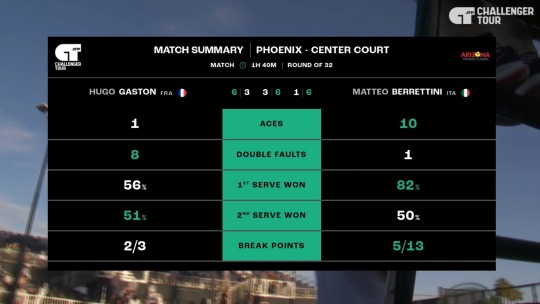
📸 ATP official website
It might have taken a while to get going for M. Berrettini, but the Italian wild card managed to get things under control as soon as he found his serve and groundstrokes combination back. Furthermore, M. Berrettini's backhand also worked perfectly in this match, especially in the last two sets while oftentimes balancing with the volleys when necessary, creating 13 break points thanks to his aggression despite H. Gaston having a 66% break point conversion rate while trying to apply his classic tricks.
On the other hand, M. Berrettini had an exceptional first serve winning percentage with 82%, 26% more than H. Gaston, aided by his 10 aces to get out of most troubles despite the first-set start to adjust himself for the play. Interestingly, even though H. Gaston double-faulted eight times, he still won 1% more second serve points than M. Berrettini with 51%, likely due to the latter's constant forehand rush earlier in the match.
In the second round, M. Berrettini will face the winner between eighth seed Arthur Cazaux or qualifier Adam Walton, which will be played today (local time). While this could be dubbed as the battle of the generations, this could be exciting to check how M. Berrettini's game fared to the current state of the Tour, especially knowing the potential of both players. Should be a fun one, with pressure points and their groundstrokes' consistency being predominantly tested!
#atp world tour#atp tour#atp challenger#atp challenger tour#tennis updates#match stats#phoenix challenger#arizona tennis classic#matteo berrettini#hugo gaston#WatchChallengersFolks#ChallengerMatters
4 notes
·
View notes
Text
NextGen Finals 2023: Challenger Frequents Making their Mark
An Introductory Post to the NextGen Finalists 2023
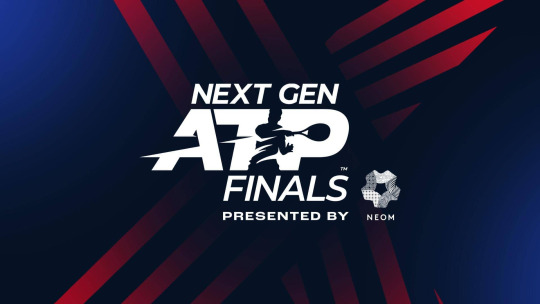
The NextGen ATP Finals 2023 logo (📸 ATP Tour)
The field for this year’s NextGen Finals, which will be held in Jeddah (Saudi Arabia) during the last weeks of November, has been set. Interestingly, just like parts of the field last year, all contenders made their mark in the ATP Challenger Tour throughout the year, which became part of the tennis Tour that showcased their potential even deeper.
This post will celebrate the next generation of tennis, serving as a recap of their season and what to expect before the Bootcamp, where everyone will get to know them better in a series of off-court challenges in one of the innovations of this year’s NextGen Finals. Furthermore, with an emphasis on the Challenger Tour, this would hopefully bring more exposure to the Challenger Tour, which became the intermediary between the rising players, those trying to rediscover their form, and those still trying to break even.
For this year, the NextGen Finals qualifying window was open until November 20, 2023, the day after the finals in 5 Challenger events this year were held. Eventually, it all came down to that week due to a possibly tight race between several players concurrently playing in several tournaments, especially Kobe and Montevideo. It took a while for the ATP to eventually finalize the finalists, and they officially announced the last 3 qualifiers earlier this Monday (November 20) despite the field looking set by the end of the second round of Kobe. They will be drawn into two groups on November 25, 2023, playing in the best-of-five mini-sets (first to 4 games).
Hereby introducing the NextGen Finalists:
1. Arthur Fils

Arthur Fils during the Montpellier (250) (📸 Next Gen ATP Finals via JB Autissier)
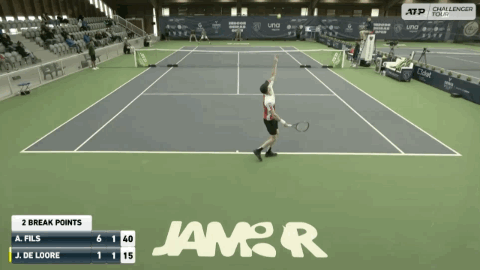
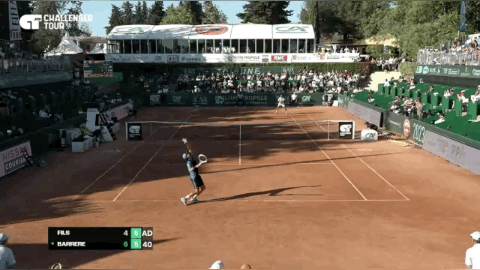
Arthur Fils' points to break 2-1 in the second set of the Oeiras 2 Challenger final against Joris de Loore (left), and to take the second set 7-5 in the Aix-en-Provence Challenger first round against Gregoire Barrere (right) (📸 ATP Challenger Livestream)
Starting this year one line below the Top 250, Fils’ meteoric rise commenced in Oeiras 2 Challenger, the start of his season, where he won the title against the previous week’s winner, Joris de Loore, 6-1, 7-6(4) through his predominantly working first serves and notably fiery passes, which often carried him until today. He continued the streak by being the Quimper Challenger runner-up to Gregoire Barrere 1-6, 4-6, which earned him the wild card to the Montpellier (250), where he became an eventual semifinalist to Jannik Sinner, as well as being a semifinalist of Marseille (250) to Benjamin Bonzi.
Since then, his potential flourished despite the rollercoaster clay season, with winning Lyon (250) as the pinnacle of his season (d. Francisco Cerundolo 6-3, 7-5), followed by a semifinal appearance in Hamburg (500) several weeks later, closing the season with a runner-up finish in Antwerp (250, l. Alexander Bublik). As a reward for his remarkable season, not only did he become the first qualifier for the NextGen Finals, but he also achieved a career-high ranking of 36 by the end of October.
2. Luca van Assche
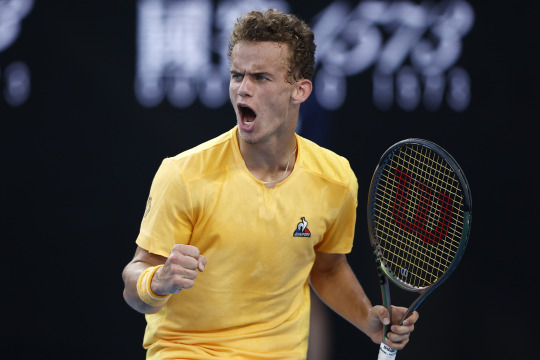
Luca van Assche's reaction upon winning the longest Challenger final of the year in Pau Challenger (📸 Tennis.com)


Luca van Assche's point to create his match point to 5-3* 40-ad in the second set of the Sanremo Challenger final against Juan Pablo Varillas (left), and to 4-3* 15-0 in the second set of the Aix-en-Provence Challenger against Andy Murray (right) (📸 ATP Challenger Livestream)
After breaking through the Top 150 by the end of 2022, van Assche had a relatively slow start to the year until he became the runner-up of the Pau Challenger at the beginning of March, where he got defeated by a resurgent Ugo Humbert in a high-quality match that lasted almost 4 hours 7-6(5), 4-6, 7-6(6) in the finals. The form did not stop until he cracked the Top 100 for the first time upon advancing to the semifinals of the Sanremo Challenger but further confirmed it once he straightforwardly defeated Juan Pablo Varillas 6-1, 6-3 for the title.
After a different set of rollercoasters in the clay season, including a notable defeat to Andy Murray in the Aix-en-Provence Challenger, van Assche continued his season beyond Challengers, as he made it to the second round of Eastbourne (250) as a qualifier, got eliminated against J.J. Wolf 2-6, 7-6(5), 1-6. During the indoor season, he made more noise again in the Orleans Challenger, where he lost against the eventual runner-up Jack Draper 5-7, 3-6 in the semifinals. He then sealed his season with a quarterfinal loss against a comeback Pierre-Hugues Herbert 6-4, 3-6, 5-7, ranking 66th by the time of this writing right before the NextGen Finals.
3. Dominic Stricker
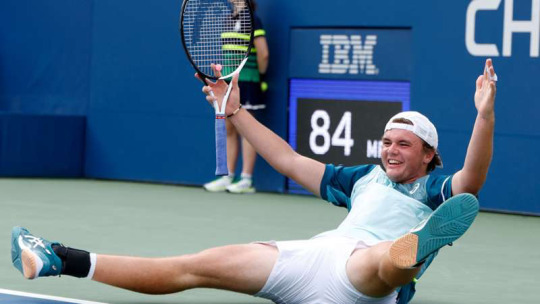
Dominic Stricker celebrated as he stunned Stefanos Tsitsipas in the US Open second round (📸 DAZN Germany via Getty Images)


Dominic Stricker's point to create one of his break points to 4-3* 40-ad in the second set of the finals of the first Prague Challenger against Sebastian Ofner (left, 📸 ATP Challenger Livestream) and also create one of his break points to *0-1 40-ad in the second set of the US Open third qualifying round against Thiago Agustin Tirante (right, 📸 Eurosport)
Despite his great potential being discovered last year (thus his NextGen Finals debut then), Stricker had to overcome several injuries and moments before he got to where he is today. Started the year straight to the Australian Open qualifying rounds, where he lost to Enzo Couacaud 7-6(2), 7-6(7) in one of the earliest Top 100 matches (when he was 18-19 lines away), he went on to win his second career Challenger title in Rovereto back in February (d. Giulio Zeppieri 7-6(8), 6-2), having won won his maiden Challenger title in Bergamo last year, followed by a home semifinal run in Lugano (l. Otto Virtanen). He then added Prague 1 Challenger to the list of the Challenger titles he won this year (d. Sebastian Ofner 7-6(7), 6-3), subsequently becoming a lucky loser in Roland Garros upon his third qualifying round loss against Thiago Agustin Tirante, which further asked the question on his ability to qualify for the Grand Slams due to the pressure moments he succumbed to during.
However, Stricker started steadily announcing himself on the bigger stage starting the grass season, steadily striking the ball more effectively and visibly improving during the pressure points/moments. Appeared competitive in the quarterfinals match of the Ilkley Challenger against Andy Murray despite the 6-7(5), 5-7 loss, and found himself qualified for Wimbledon after enduring a 4-set match against Mattia Bellucci in the third qualifying round. He then qualified for the US Open despite the subpar mini-clay season and build-up and asserted his revenge against Tirante (to whom he lost the final qualifying round in Roland Garros), successfully advancing to the fourth round in a competitive loss against Taylor Fritz after winning his third-round match against Benjamin Bonzi. Eventually, despite the end-of-season rollercoaster, his quarterfinal run in Basel (500) (l. Ugo Humbert) confirmed his Top 100 finish attained back in the US Open but unfortunately had to retire (for likely precautionary measures) in Ismaning Challenger at 7-6(2), 1-4 against Rudolf Molleker in hopes to be ready for his second NextGen Finals appearance.
4. Flavio Cobolli

Flavio Cobolli in action during Olbia Challenger (📸 OA Sport)
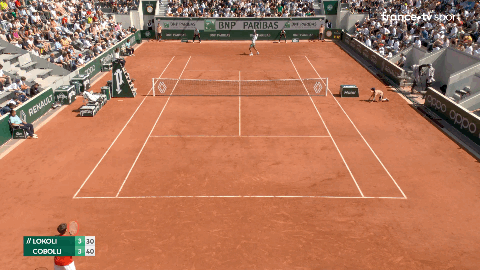
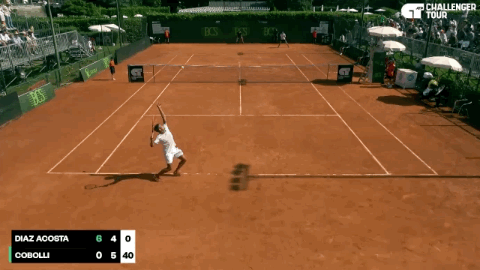
Flavio Cobolli's point to break 4-3 in the first set of the Roland Garros third qualifying round against Laurent Lokoli (left, 📸 France TV Sport), and to take the second set 6-4 during the Milan Challenger final against Facundo Diaz Acosta (right, 📸 ATP Challenger Livestream)
Trying to live up to his discovered potential last year thanks to his aggressive play (and often going deep on important occasions), Cobolli started his season with a second-round run in Pune (250), where he lost against Botic van de Zandschulp 5-7, 4-6. He then started to sparkle in Munich (250), where he ended up as a quarterfinalist (l. Christopher O’Connell), followed by a semifinal showing in Rome (Italy) Challenger (l. Jesper de Jong) and Milan Challenger (l. Facundo Diaz Acosta). In a similar timeframe (clay season, its extension, and Challenger’s own clay season), he also qualified for the Roland Garros, where he ended up being defeated by Carlos Alcaraz 0-6, 2-6, 5-7 in the first round. Fast-forward to the end of July, in almost the same tournament he finally got himself known in Umag (250), he became a quarterfinalist after the loss against Matteo Arnaldi in an all-Italian-NextGen showing.
He then continued his stellar showing in the clay Challengers, where he reached the semifinals in Tulln (l. Sumit Nagal) and won the title in a close encounter in Lisbon (d. Benjamin Hassan 7-5, 7-5), citing Cristiano Ronaldo as his title run inspiration during the post-finals press conference. Furthermore, outside of the clay-court Challengers, he still managed to maintain the streak in the Olbia Challenger, where he was out-paced by Titouan Droguet during the finals, hence his runner-up finish after a 3-6, 4-6 loss. After two early exits in Bergamo and Helsinki Challengers, both of which were indoor hard tournaments, Cobolli had a semifinal showing in Danderyd by defeating Gilles Arnaud Bailly in the first round 6-4, 6-1, advanced to the quarterfinals at the cost of Gauthier Onclin’s withdrawal before winning against Radu Albot 6-4, 7-6(5) in a close encounter that confirmed his NextGen Finals qualification, but was overwhelmed when dealing with eventual champion Maximilian Marterer’s serve+1s in the semifinal.
5. Alex Michelsen
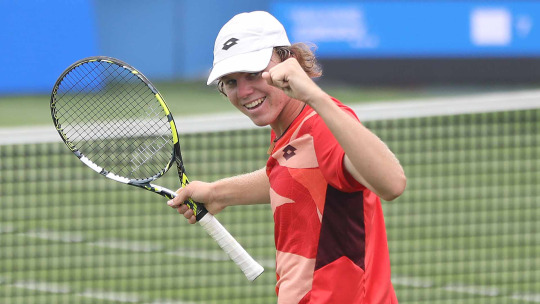
Alex Michelsen in Newport, where he became the runner-up to Adrian Mannarino (📸 ATP Tour)

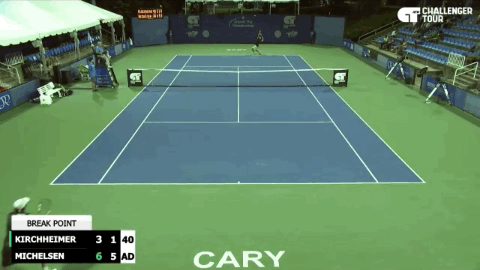
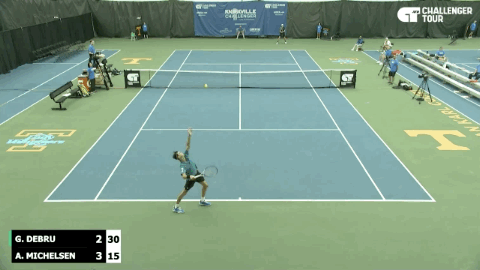
Alex Michelsen's point to break 2-0 in the second set of the Rome, GA Challenger quarterfinals against Edan Leshem (top left), to take the second set 6-1 in the second Cary Challenger second round against Strong Kirchheimer (top right), and to *2-3 30-30 in the first set of the Knoxville Challenger second round against Gabriel Debru (bottom) (📸 ATP Challenger Livestream).
Starting the year precisely at World No. 600, A. Michelsen’s rise started in the Rome, Georgia (USA) Challenger in February, where he became the runner-up to Jordan Thompson 4-6, 2-6 right after becoming the runner-up of the ITF M25 Malibu (Jan 2) and winning the ITF M15 Edmond, Oklahoma (Jan 23), followed by a semifinal showing in Waco Challenger a week after Rome, GA, which earned him the wild card to the Indian Wells M1000 qualifying (l. Leandro Riedi in Q1). After another solid showing in the ITFs (including a runner-up in M25 Calabasas-Mar 20), A. Michelsen started to get out of his comfort zone and tried the Nottingham Challenger in the grass courts of the United Kingdom (l. Gabriel Diallo in R2 6-3, 5-7, 2-6 as a qualifier) and had a competitive appearance in Mallorca (250) as a qualifier (l. Christopher Eubanks in R1 3-6, 7-6(5), 5-7) before winning his maiden Challenger title in Chicago (d. Yuta Shimizu 7-5, 6-2), further strengthening his explosive and intuitive play as the year progressed.
A week after his Chicago Challenger title, he became a runner-up in the grass courts of Newport (250), where Adrian Mannarino eventually won 6-2, 6-4 and after notably defeating Maxime Cressy, James Duckworth, Mackenzie McDonald, and John Isner from the first round until the semifinals. However, the next few tournaments became tricky with the Top 100 in sight, including a semifinal loss against eventual champion Zachary Svajda in the Cary 2 Challenger. He then got his rewards to finally enter the Top 100 for the first time after winning the Knoxville Challenger title, when he survived four three-setters in five rounds, defeating Denis Kudla 7-5, 4-6, 6-2 as the pinnacle, solidified his position by defeating Bernard Tomic 6-4, 6-0 in the Champaign Challenger’s first round in a rematch of their last week’s close encounter in Knoxville. Ultimately, A. Michelsen became the runner-up of the Champaign Challenger to Patrick Kypson, where he confirmed his NextGen Finals participation, as well as his Australian Open 2024 main draw direct entry likelihood thanks to his Top 100 year-end finish, landing at 94 live.
6. Hamad Medjedovic
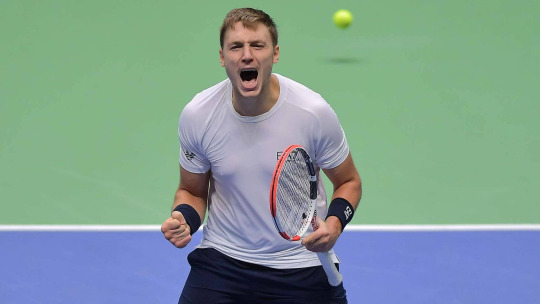
Hamad Medjedovic celebrated after defeating Jiri Lehecka in Astana (250) for the biggest win in his career (by then) (📸 ATP Tour via Kazakhstan Tennis Federation)
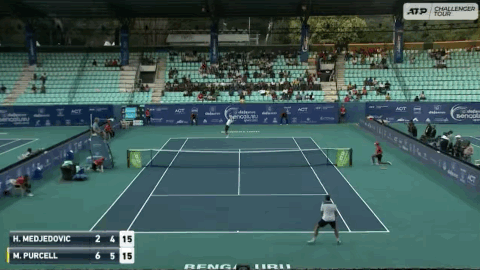
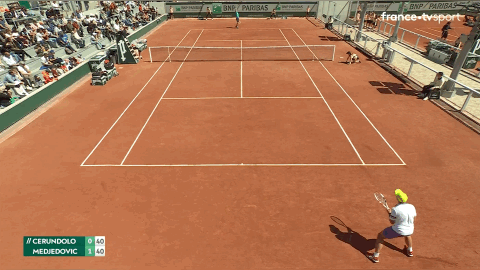
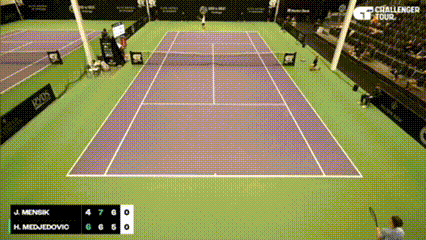
Hamad Medjedovic's point to 6-5* 15-30 in the second set of the Bengaluru Challenger semifinal against Max Purcell (top left, 📸 ATP Challenger Livestream), to create the break point to *0-1 40-ad in the second qualifying round of Roland Garros against Juan Manuel Cerundolo (top right, 📸 France TV Sport), and to 6-5* 15-0 in the third set of the Danderyd Challenger second round against Jakub Mensik (bottom, 📸 ATP Challenger)
Medjedovic came a long way after his rise last year, winning the Luedenscheid Challenger 2022 by double-breadsticking Zhizhen Zhang, steadily answering the doubt on whether or not he’s breaking even, even if he has Novak Djokovic’s support. After having a slow start to the season (and an even slower second semester of 2022), he started having deep runs in the Bengaluru Challenger, where he was eliminated in the semifinal against eventual champion Max Purcell 2-6, 7-5, 6-7(4). However, he then started his stellar Challenger clay season with a title in Szekesfehervar Challenger (d. Nino Serdarusic 6-4, 6-3), followed by another title in Mauthausen (d. Filip Misolic 6-2, 6-7(5), 6-4) in a rain-ridden dramatic match. To top it off, he qualified for the Roland Garros and Wimbledon but got eliminated against Marcos Giron and Christopher O’Connell in the first round, respectively.
Trying to rise the ranks to the main Tour, he followed those up by having several great runs in the 250s and the Challengers in the second half of 2023, carried by his powerful serve and forehands when they are on (and occasionally, drop shots and volleys to add to his intuitive play). He started with a semifinal run in Gstaad as a qualifier (l. Pedro Cachin 3-6, 1-6, with a notable win against Dominic Thiem in the second round in a rematch of their Mauthausen Challenger semifinal encounter, as well as winning the Mallorca Challenger (d. Harold Mayot 6-2, 4-6, 6-2). He topped those runs off with a semifinal run in Astana (250) (l. Sebastian Korda, with some notable wins against Alexander Shevchenko and Jiri Lehecka in the second round and quarterfinals, respectively) despite the early exits in the last 3 250-level tournaments (Antwerp (250) R1, Basel (500) Q1, and Sofia (250) R1). Subsequently, after defeating Stefano Travaglia 6-4, 6-3 in a chaotic first-round match, he was defeated by fellow up-and-coming NextGen player Jakub Mensik 4-6, 7-6(2), 7-6(8) in the second round, having his 3 match points saved, 2 of them in the second set and one when he should have served for the match. Recognizing his tremendous potential through his aggressive gameplay and often reliable serves, while his usual rollercoaster could be expected, it all depended on his intuition in handling the point construction within the longer rallies if he could not keep it short.
7. Luca Nardi
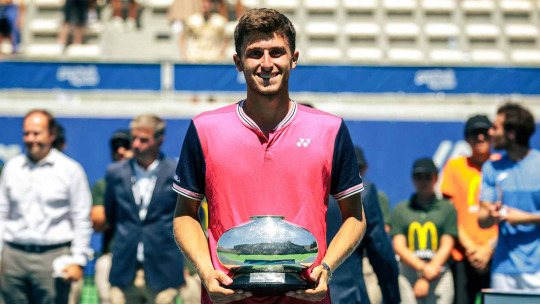
Luca Nardi won the Porto Challenger title in August this year, gifting himself his birthday present after three hard-fought sets (📸 ATP Tour via Porto Open)

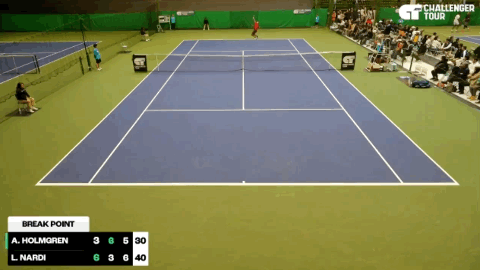
Luca Nardi's point to 6-5* 0-15 in the third set of the Pune Challenger semifinal against Dominik Palan (left) and to take the third set 7-5 in Kobe Challenger against August Holmgren (right) (📸 ATP Challenger Livestream)
Another name with potential being further discovered since last year is Luca Nardi, who answered the doubts coming from his sloppy start of the year by making strides toward the end of the year, thus rewarded with NextGen Finals qualification. He exited in early rounds in the first one-two months of the calendar before reaching the finals of the Pune Challenger, where he became the runner-up to a red-hot Max Purcell 3-6, 2-6. The rollercoaster then continued to the clay season, where he was remembered for being double-bageled by Lorenzo Musetti during the second round as a qualifier during the Monte Carlo M1000, as well as advancing to at least the quarterfinals in several Challengers, notably in Vicenza (l. Pablo Llamas Ruiz) and Milan (l. Matteo Gigante).
Realizing the whole rollercoaster, L. Nardi’s more offensive approach to complement his defenses and return depth started to pay off in Porto Challenger back in August, where he pulled a comeback win against Joao Sousa 5-7, 6-4, 6-1 as a sweet birthday present he gifted himself. Since then, his trajectory has gone back on track by being the semifinalist of the Bratislava 2 Challenger (l. Joris de Loore) and finally took the title in the Matsuyama Challenger in another comeback fashion (d. Taro Daniel 3-6, 6-4, 6-2), securing his NextGen Finals place after his second-round victory in the Kobe Challenger just to start the week (d. August Holmgren 6-3, 3-6, 7-5) before falling to Sho Shimabukuro to the semifinals, showing that his decision to partake in the Japanese Challenger swing paid off for his almost last-minute qualification.
8. Abdullah Shelbayh [WC]
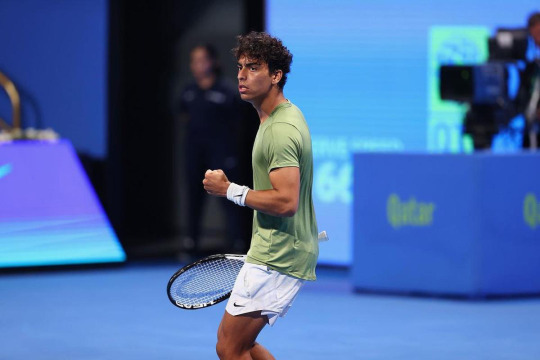
Abdullah Shelbayh during his first-round match in Doha (250) (📸 The Hindu via Abdullah Shelbayh's Instagram post)


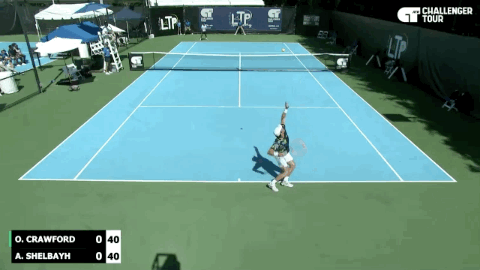
Abdullah Shelbayh's point to *5-2 40-40 (one of the break points saves) in the second set of the second-round Tenerife 3 Challenger match against Ryan Peniston (top left), to break 5-2 in the second set of the Manama Challenger semifinal against Salvatore Caruso (top right), and to *0-0 40-ad (second break point) in the Charleston Challenger final against Oliver Crawford (bottom) (📸 ATP Challenger Livestream)
Hailing from Jordan and training in Rafa Nadal Academy under Princess Lara Faisal’s Rise for Good Foundation, Shelbayh exceptionally started the season as a runner-up of the ITF M25 Manacor against Daniel Rincon (Jan 23) in a marathon match to start his positive semester after his remarkable rise kicked off in the second semester of 2022, from winning ITF M25 Monastir on two occasions (Jul 18 & Aug 22, 2022) before closing that year by winning ITF M15 Trnava (Dec 5) against Daniel Rincon, several months after securing his Challenger debut with a semifinal appearance (l. Zizou Bergs, but notably d. 1st seed Dominic Stricker in the first round). The only way was up, which he proved throughout the 2023 season by reaching the second round in Tenerife 3 Challenger as a qualifier (l. Ryan Peniston), ultimately becoming the runner-up in his maiden Challenger final in Manama (l. Thanasi Kokkinakis). He backed this up with his maiden ATP Tour main draw appearance in Doha as a wild card despite the first-round loss against Soonwoo Kwon.
He kept gaining experience as the year passed by from the aforementioned raw potential, making a last-minute decision to partake in the Banja Luka qualification rounds, stunning then-have not broken out (yet) Fabian Marozsan and Lukas Klein in both qualifying rounds before defeating Elias Ymer 6-1, 7-5 in the first round to record his maiden Tour-level victory (as well as becoming the first Jordanian to win a main Tour match) but was eliminated in the hands of Miomir Kecmanovic. He also qualified for the Mallorca (250) event on grass (l. Roman Safiullin in the first round) and went on to win his maiden Challenger title in Charleston (d. Oliver Crawford 6-2, 6-7(5), 6-3), also becoming the first Jordanian Challenger-level champion. His sparkling rise continued through Metz (250) as a qualifier (d. Dan Added & Gijs Brouwer in the qualifying rounds), shocking Hugo Gaston 7-6(5), 6-2 before Lorenzo Sonego defeated him 3-6, 5-7 despite his competitive efforts. Aided by his often impressive point construction (as displayed), when he is on, not only rewarded him his career-high ranking of 187 (attained Nov 20, 2023) but also a wild card to this year’s NextGen Finals as the regional (Middle Eastern) representative.
#atp tour#atp world tour#atp challenger#atp challenger tour#tennis news#tennis updates#nextgen finals#nextgen finals 2023#introductory post#arthur fils#luca van assche#dominic stricker#flavio cobolli#alex michelsen#hamad medjedovic#luca nardi#abdullah shelbayh#WatchChallengersFolks#ChallengerMatters
9 notes
·
View notes
Text






📸 🎥 ATP official website
Just like the first set, D. Popko had his chances in the second set, but it was not materialized for whatever reason. After 3 consecutive holds, in the beginning of the fourth game, P. Carreno Busta had a backhand down-the-line winner for his one-point lead before having several break points due to D. Popko's +1 forehand rushes, but the latter saved the said break points before holding his serves to 2-2. This turned out to be a massive hold as the Spanish wild card committed numerous +1 errors that resulted in D. Popko's break of serve to 3-2, followed by a consolidation to 4-2.
Somehow, in the ninth game, D. Popko earned his chance to serve for the second set. However, the Kazakh eighth seed had a failed forehand response to P. Carreno Busta's drop shot, which was timely before the latter's volley generated his break point. Ultimately, a double fault converted the break point (5-5), and P. Carreno Busta strengthened his position with a service game hold to 6-5. Subsequently, another series of errors created the latter's match points, which, albeit 2 of them being foiled, P. Carreno Busta also created another one through his preceding forehands, but it was fumbled again until D. Popko held to 6-6, where the tie-breaker became inevitable.
During the tie-breaker, a forehand winner from P. Carreno Busta set up his mini-break lead to 4-2, but a forehand error 2 points later neutralized it to 4-4. It took 2 points later for the Spanish wild card to generate his match point through D. Popko's forehand error (6-4), which was immediately converted that not only P. Carreno Busta took the second set 7-6(4) but also for him to secure his second-round appearance for his first victory of the year.
#atp world tour#atp tour#atp challenger#atp challenger tour#tennis updates#hot shots#break point#set point#poznan challenger#enea poznan open#pablo carreno busta#dmitry popko#WatchChallengersFolks#ChallengerMatters
2 notes
·
View notes
Text




📸 🎥 ATP official website
The third set chaos continued as L. Musetti successfully found his lines. This allowed him to outhit N. Borges, where another failed drop shot secured the former's latest break point before breaking early to 1-0 to start the third set. He then continued by consolidating his serves to 2-0, and seemed not looking back as he found his range, firing a cross-court forehand winner as he was comfortable through the angles to set himself one point ahead, where he doubled the break.
However, it was yet to be a demolition even if L. Musetti won the first point of the fifth game through the lines as the Portuguese seventh seed tried to put his name on the board through a service game hold to 4-1. He tried his best to stay aboard, even engaging in some extended rallies as he tried to find some groove, winning a 36-shot rally that ended with L. Musetti's forehand error to generate his latest break point before breaking back to 4-2. However, his forehand errors in the last 2 points resulted in L. Musetti's break-back to 5-2, where he earned an opportunity to serve for the match. Without further hesitation, he successfully did, taking the third set 6-2 to secure his spot in the semifinals.
#atp world tour#atp tour#atp challenger#atp challenger tour#tennis updates#hot shots#break point#match point#cagliari challenger#sardegna open#nuno borges#lorenzo musetti#WatchChallengersFolks#ChallengerMatters
2 notes
·
View notes
Text







📸 🎥 ATP official website
Despite having several more highlight-reel materials in the second set, the question to A. Walton's range became imminent as Gio gained his point construction through a slightly slower pace of the court. It was confirmed as soon as the fourth seed got broken early due to his +1 forehand error for Gio's break point before it was converted through a forehand error (2-1). Even though A. Walton had a slight chance through a forehand pass, Gio managed to hold his service games to 3-1, and had not looked back since.
It took three more games before Gio got even more aggressive from his forehand side, and somehow, parts of the match turned out to be its own show. To start off, Gio fired a forehand winner for his one-point lead, and forced a deuce through another forehand down-the-line winner. A successful lob even secured the fifth seed's break point, to no avail as A. Walton foiled it due to Gio's forehand error, where he ended up holding his serves to 4-3. A. Walton also came up with a lob winner several points into the next game, but the Frenchman still held his serves to 5-3.
Subsequently, A. Walton should have served to stay in the set, but his first few errors generated Gio's 2-point lead instead. The latter then saw this as an opportunity to pass his forehand, producing his initial match point that even if A. Walton saved one of them, it was insufficient as another one resulted in Gio breaking for the match, also taking the second set 6-3 to win his second title within the fortnight.
#atp world tour#atp tour#atp challenger#atp challenger tour#tennis updates#hot shots#break point#set point#acapulco challenger#gnp seguros tennis open#adam walton#giovanni mpetshi perricard#WatchChallengersFolks#ChallengerMatters
2 notes
·
View notes
Text











📸 🎥 Tennis Channel 2, ATP official website
Even though it might have seemed that N. Borges had the momentum while setting up the second set, M. Berrettini did not back down until the last point, which made the second set even more than a fascinating watch. Right in the first game, M. Berrettini tried to make N. Borges scramble to put the ball in, but eventually misfired his intended forehand down-the-line for the latter's game point before he held to 1-0. Fast-forward to the seventh game, another notable point came from the Italian wild card as he struck with his intuitive volley finish to minimize the gap even if N. Borges still held his serves to 4-3. By then, the match got better, and the margin became even close.
However, an erratic service game from M. Berrettini, which was marked by his forehand errors and even a double fault to conclude the set earned the Portuguese to initially serve for the match. Initially, because even if he came up with a gap-minimizer drop shot trying to close it out, M. Berrettini pushed through his returns to break back 5-4 thanks to his deep forehand return to N. Borges' +1 backhand error. The former's failed volley, in the next game, forced a deuce before he had to save a match point made out of his unforced error with an ace, where he finally held the tenth game (5-5) thanks to his cross-court forehand winner. Eventually, the penultimate points of the next game had N. Borges' backhand down-the-line winner for his game point foiled out of M. Berrettini's functional volley before N. Borges held his serves to 6-5 a point after the second backhand let-cord moment of the game.
The next known thing, M. Berrettini once again was challenged from the baseline, where moments after scoring a rare one-handed backhand down-the-line winner a la Richard Gasquet, he faced another match point out of an unforced error saved with an ace. Ultimately, it was the tie-breaker once again that determined the end of the second set, where even though M. Berrettini earned his moments from N. Borges' forehand error early on (1-0) prior to a 3-0 lead, the latter's wind-aided drop shot minimized the gap to 3-2 before his line-painting volley set up his lead to 5-4. At the end of the match, M. Berrettini's forehand misfires caused N. Borges to take the second set 7-6(4), thus he became Phoenix Challenger's first repeat champion without rushing to the Miami qualifying rounds.
#atp world tour#atp tour#atp challenger tour#atp challenger#tennis updates#hot shots#break point#match point#phoenix challenger#arizona tennis classic#nuno borges#matteo berrettini#WatchChallengersFolks#ChallengerMatters
2 notes
·
View notes
Text
Phoenix Ch QF: Matteo Berrettini [WC] def. Terence Atmane [Q] 3-6, 7-6(2), 7-6(6) Match Stats

📸 Tennis Channel 2
It took a while, once again, for M. Berrettini to find his range from his forehand. Often, this influenced his point construction, but T. Atmane ended up appearing clutch on serve, which was evident in the ninth game of the third set among any other moments in this match. However, M. Berrettini timely fired his forehand winner to secure the key point of the third set tie-breaker, which was closer than how he dominated the second one, which paved the way to his victory. The said forehand influence was also predominantly behind 8 of his break points despite T. Atmane's deep returns converting 2 out of his 7 break points from the first set and the beginning of the second set before M. Berrettini struck back.
On the other hand, it appeared that the difference between both players were thin. M. Berrettini fired 10 aces than T. Atmane's 4, allowing him to have the slight edge from the first serves by 3% with a 76% winning percentage, which helped him nailing some pressure points on his serve. However, even though he double-faulted just twice than T. Atmane's 5, he won 4% lesser points than the Frenchman, which was a consequence of his forehand errors while trying to follow up to T. Atmane's deep returns on his serve, but it was insufficient for T. Atmane to sustain in this match.
Shortly (local time) as this was written, seventh seed Aleksandar Vukic awaits, who earlier defeated Quentin Halys 6-4, 6-4 in an almost simultaneous manner, but way earlier due to Halys' double faults that concluded the set. This turned out to be a rematch of their second-round encounter in the Phoenix Challenger last year, where outside of the possible servefests, M. Berrettini's forehand became the key to mini-break at the second set tie-break to win the match, while he went after A. Vukic's forehand to secure the only break of the match back in the first set. Should be an intriguing one to see how and if the Italian wild card could find his range, sooner or later.
#atp world tour#atp tour#atp challenger#atp challenger tour#tennis updates#match stats#phoenix challenger#arizona tennis classic#matteo berrettini#terence atmane#WatchChallengersFolks#ChallengerMatters
2 notes
·
View notes